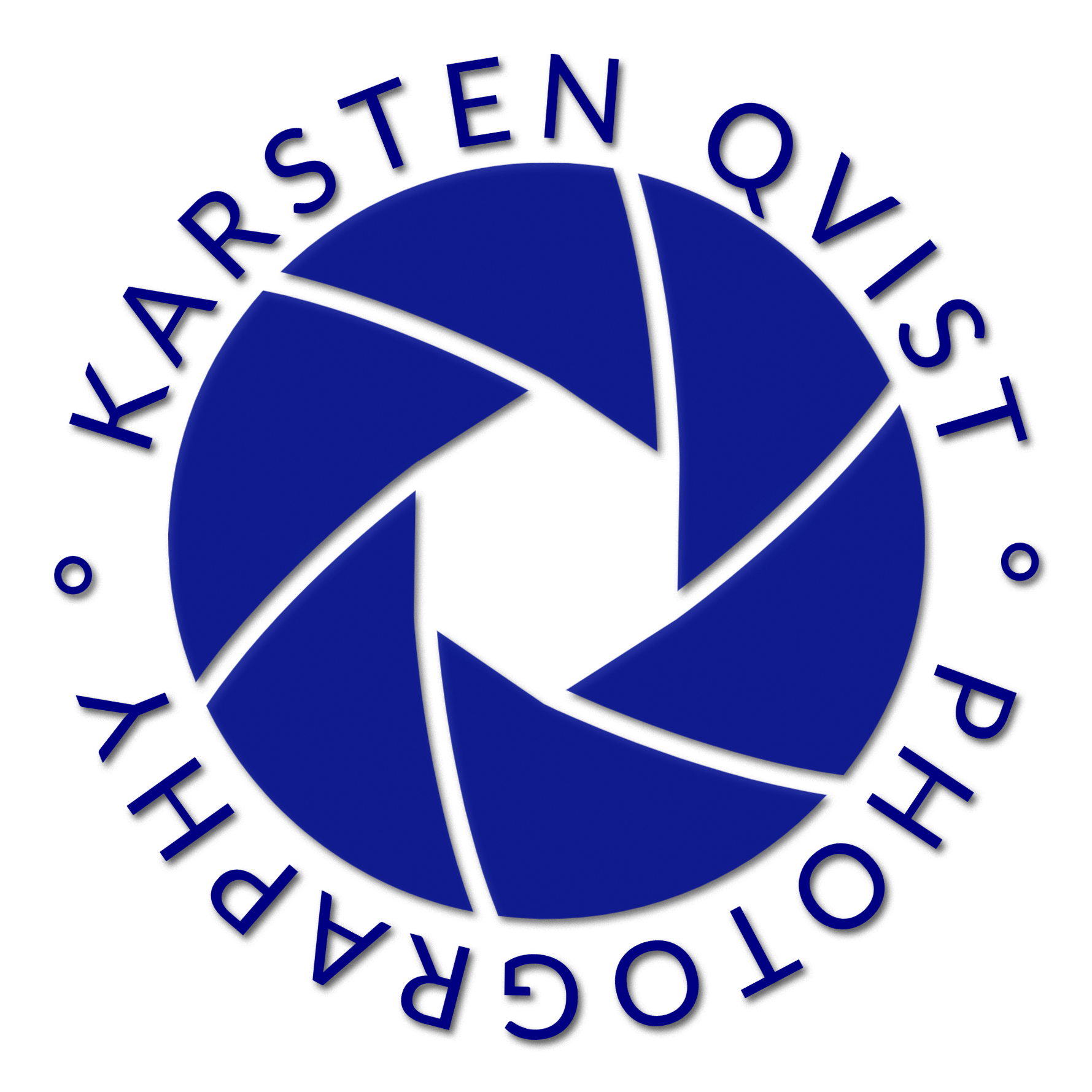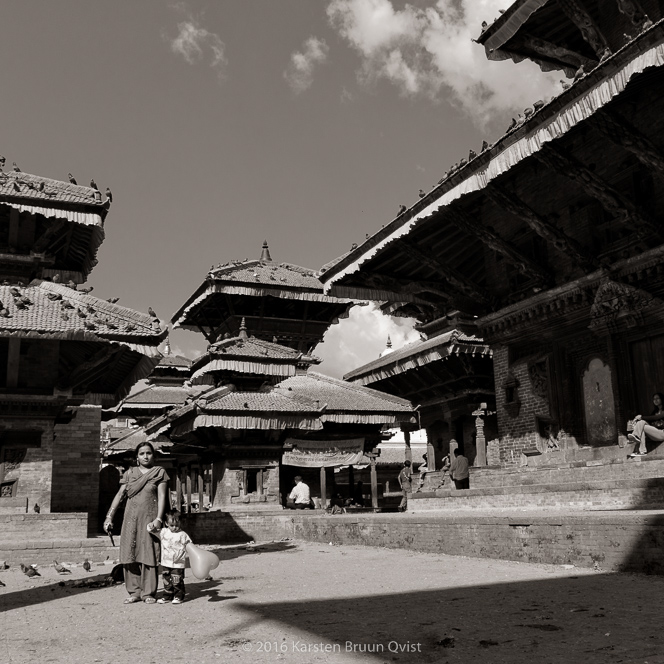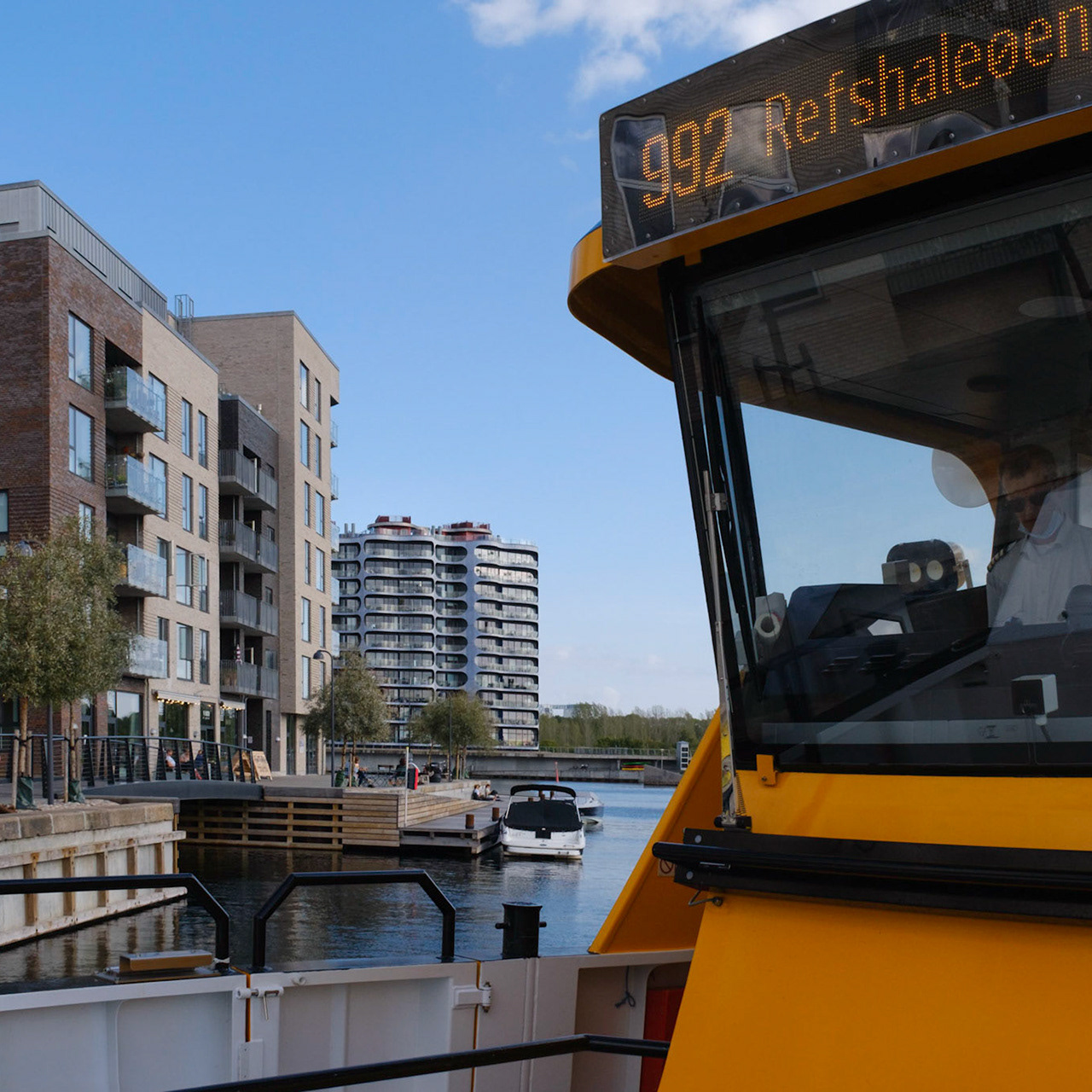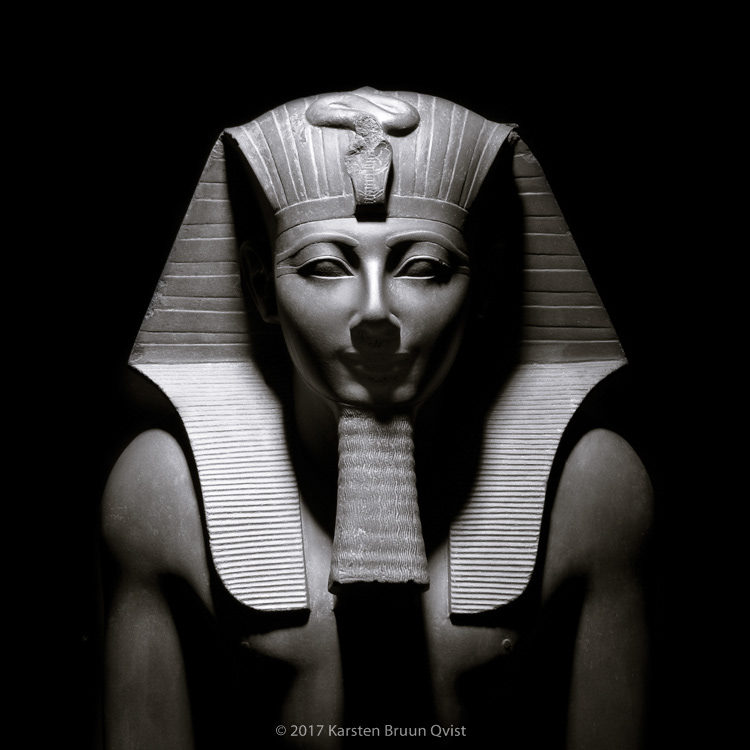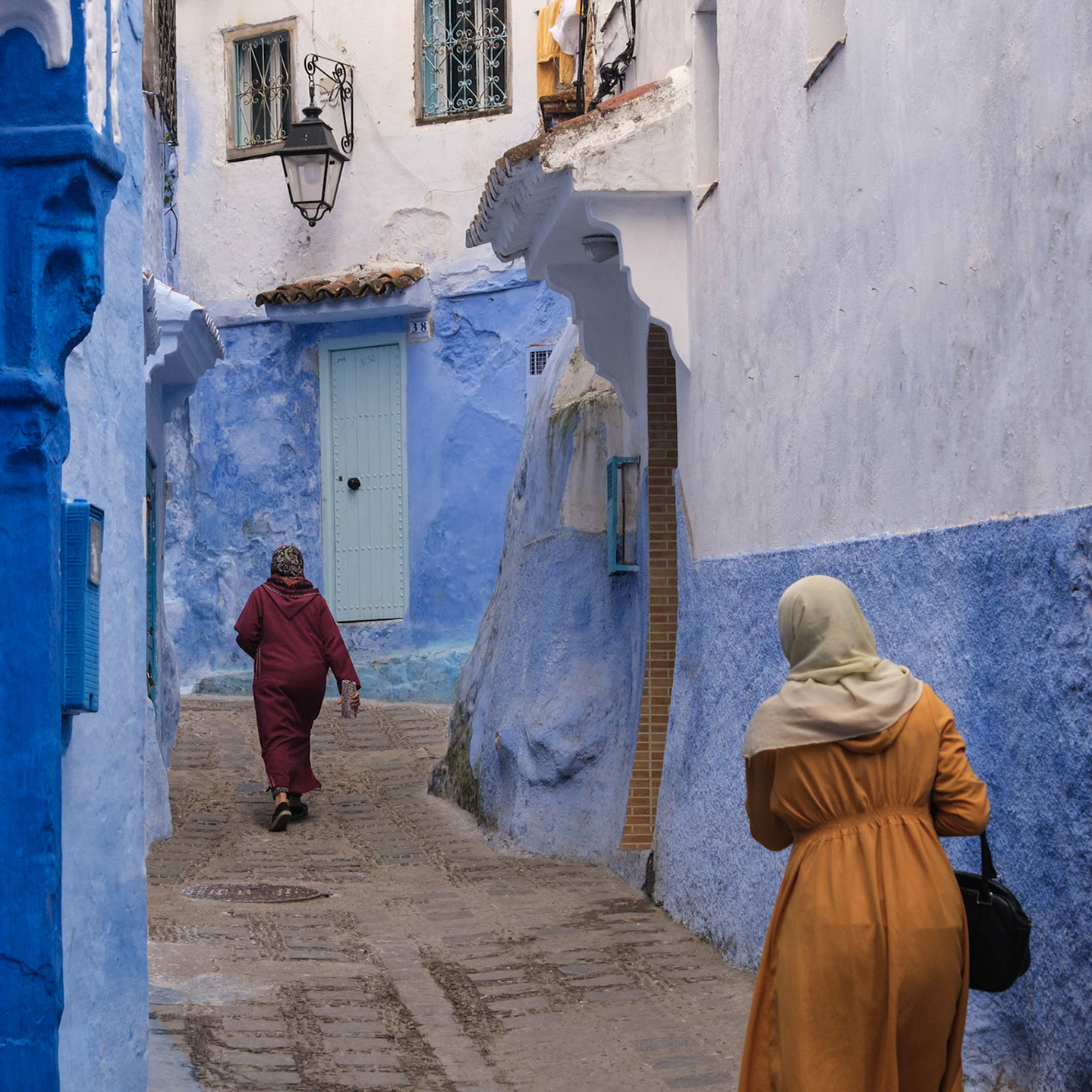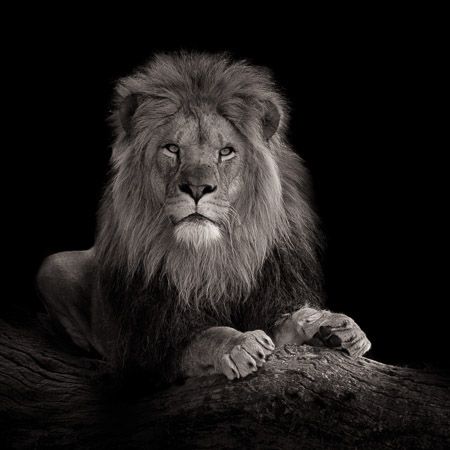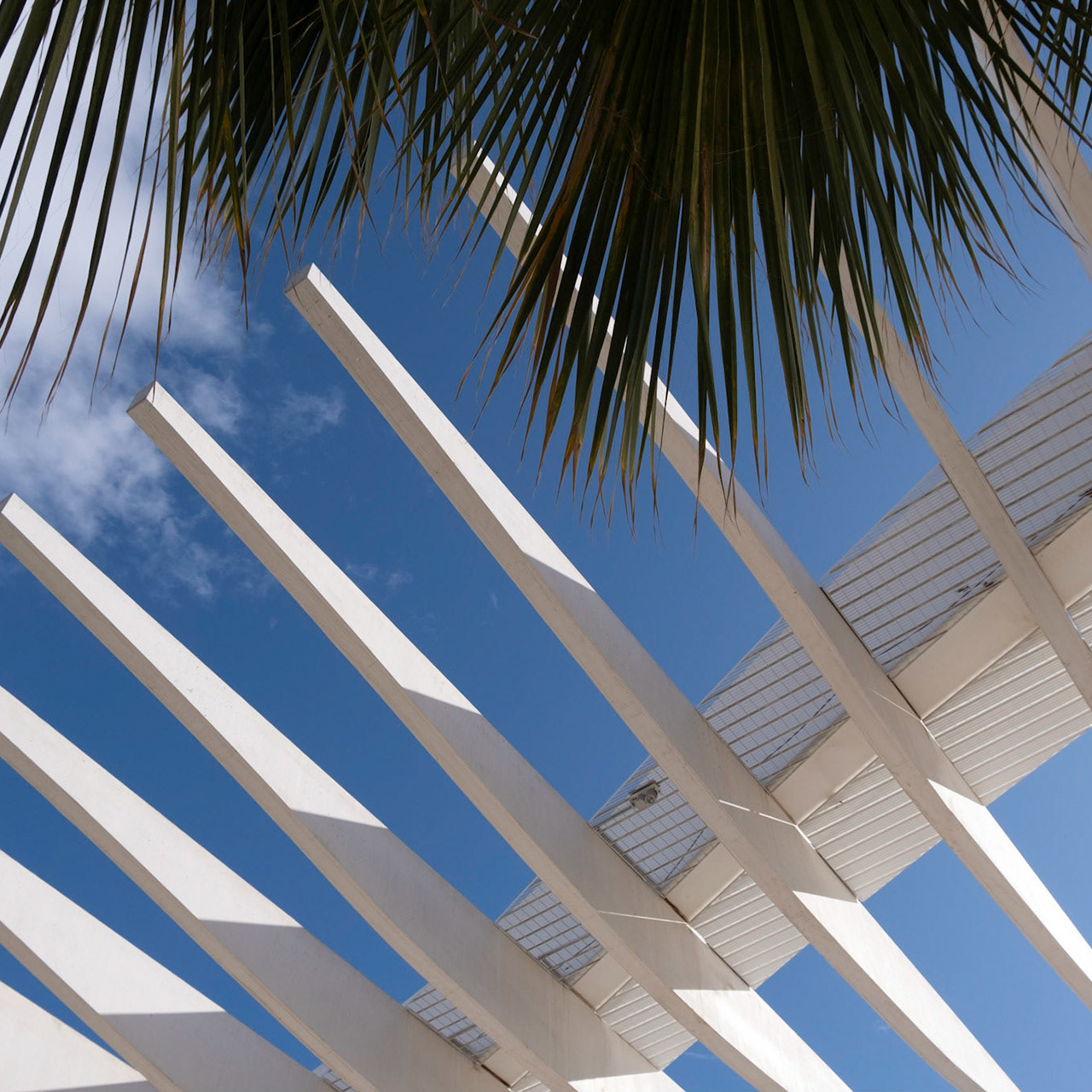Photographs recorded during the Timkat festival in Gondar, Ethiopia in January of 2018.
All rights reserved.
All rights reserved.
Introduction
Timkat is considered the biggest religious festival of the Ethiopian Orthodox Tewahedo Church. It is celebrated in January and commemorates the baptism of Jesus by John the Baptist. Timkat involves large, colorful processions that move the so-called Tabot, a consecrated replica of the tablets of the Ten Commandments from its home in the innermost part of the church to a nearby body of water.
In major cities, tens of thousands of enthusiastic participants may follow the procession, with much singing, chanting, drumming and dancing. At the end of a nightly outdoor service that lasts several hours and culminates around dawn, the head priest blesses the body of water with a huge gilded cross. Immediately following this, some participants jump into what is now Sanctified Water, while priests spray those staying outside with garden hoses. A few hours later, the Tabots are taken back to their respective churches with processions no less impressive than the ones the day before.
Timkat celebration in the city of Gondar is particularly spectacular, with a more than 2 km procession route, and a 17th century pool and complex hosting the main ceremony.
For a fuller description of Timkat, and what can be seen in the photographs, continue reading below the images. For larger photos, click/tap on an image.

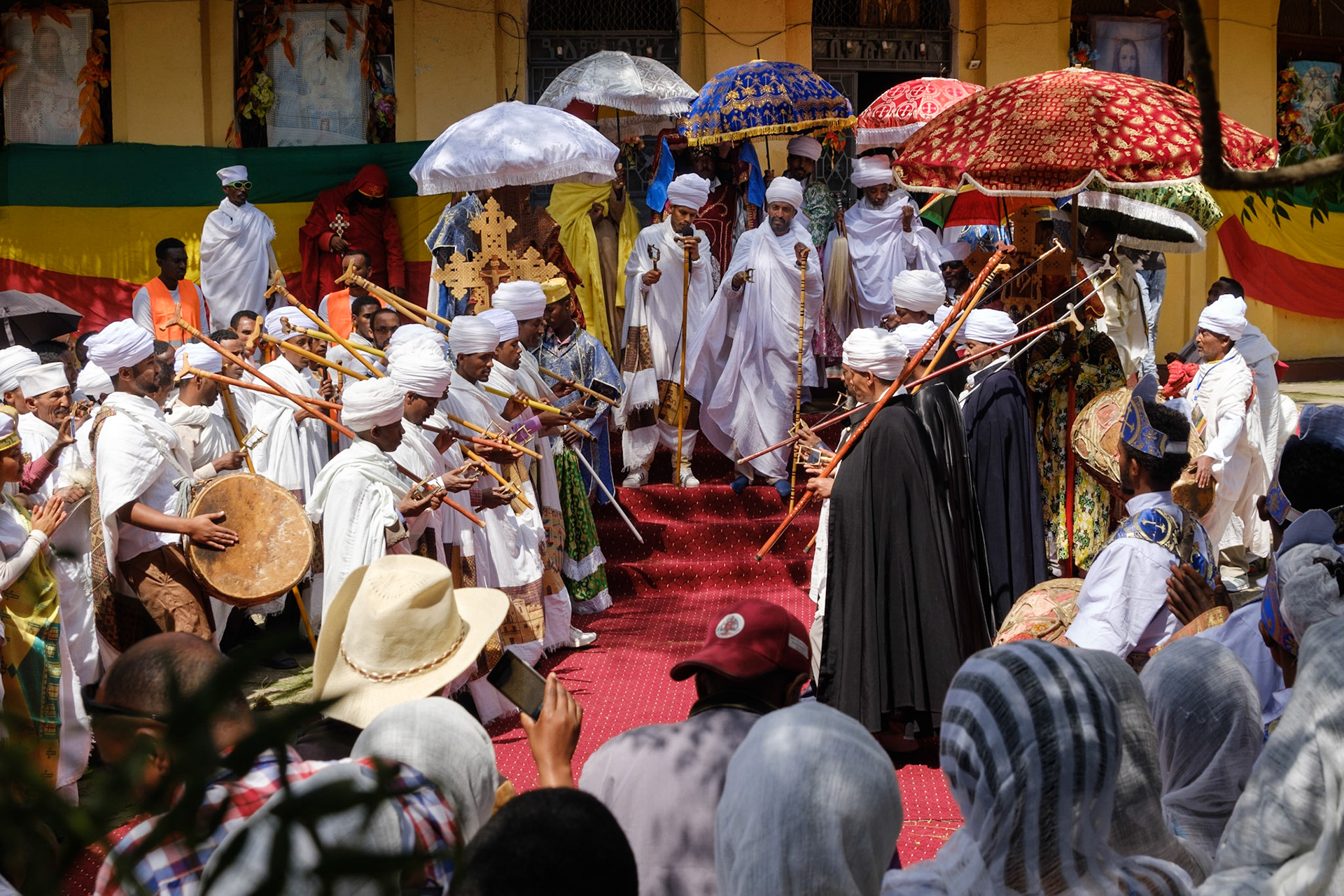
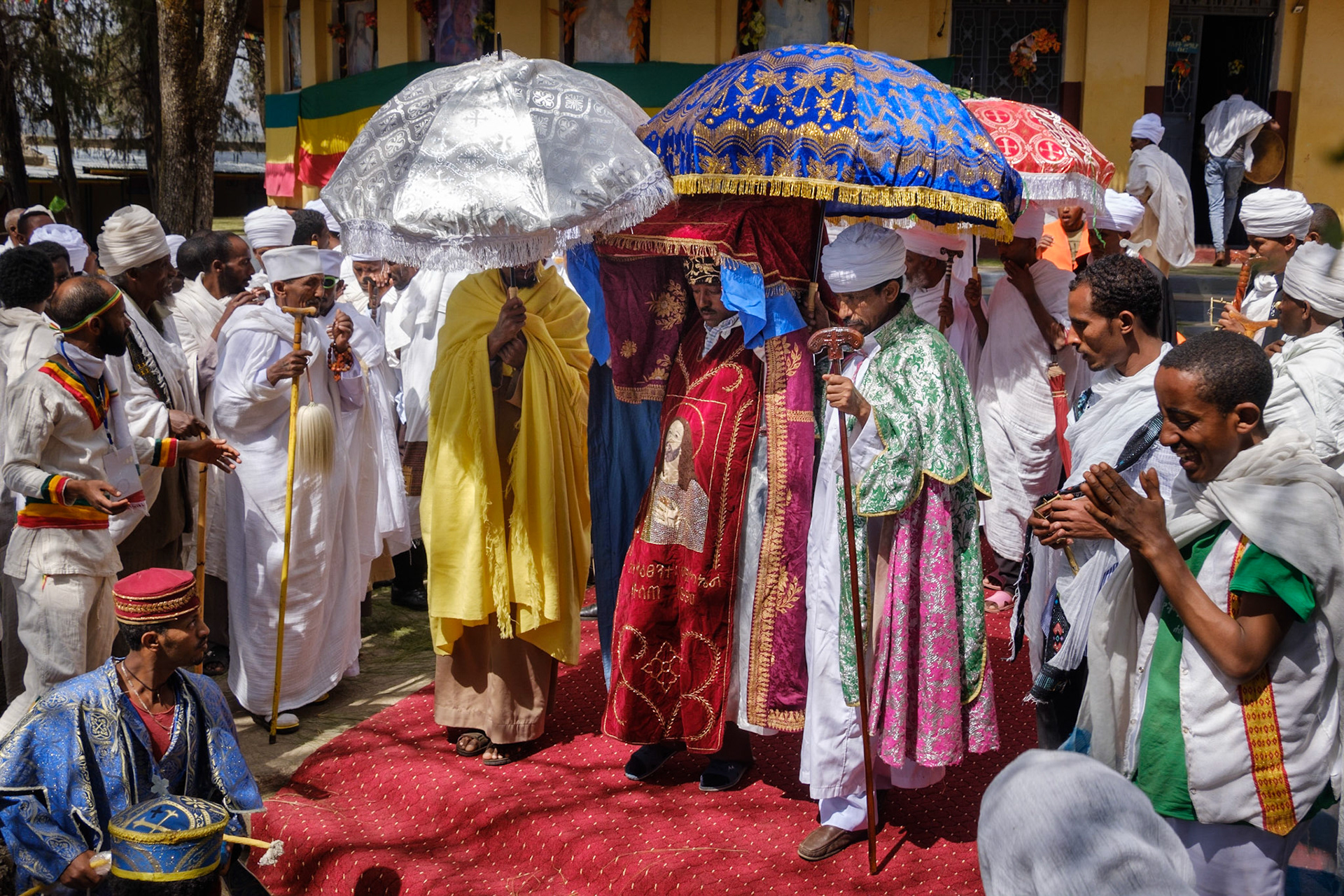
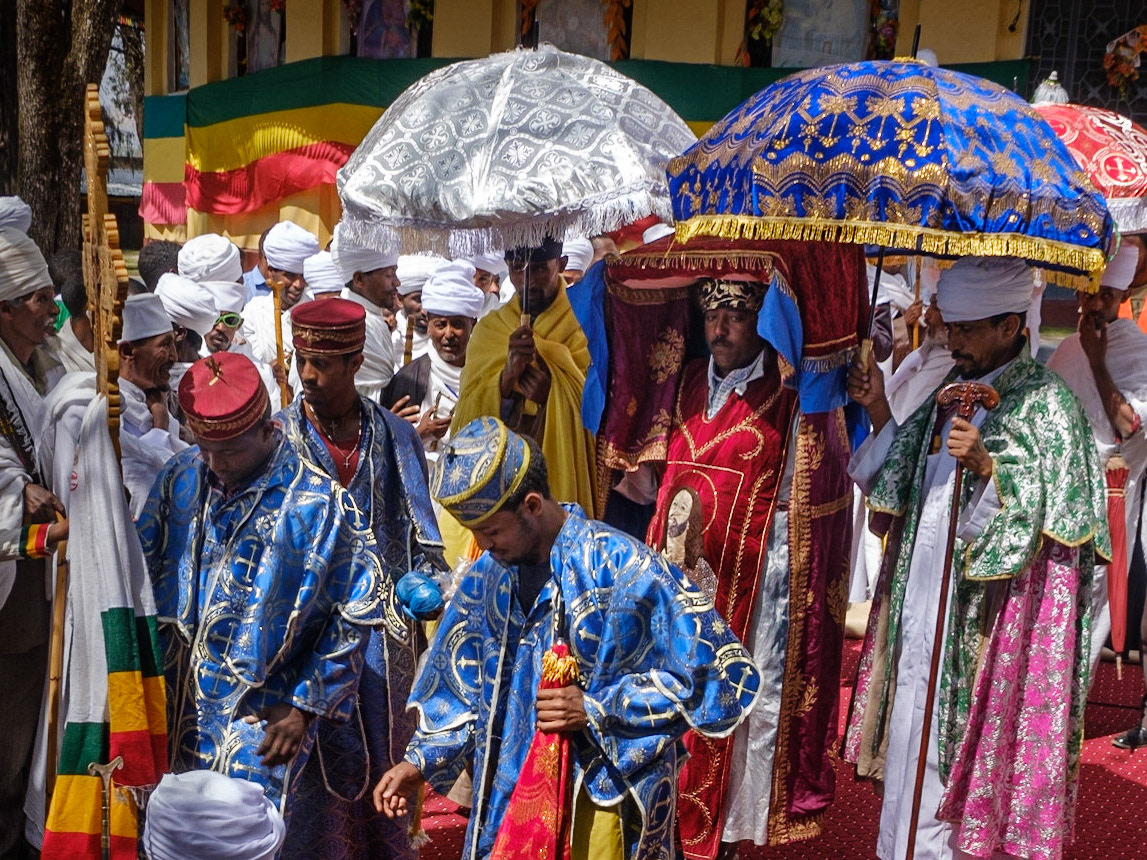

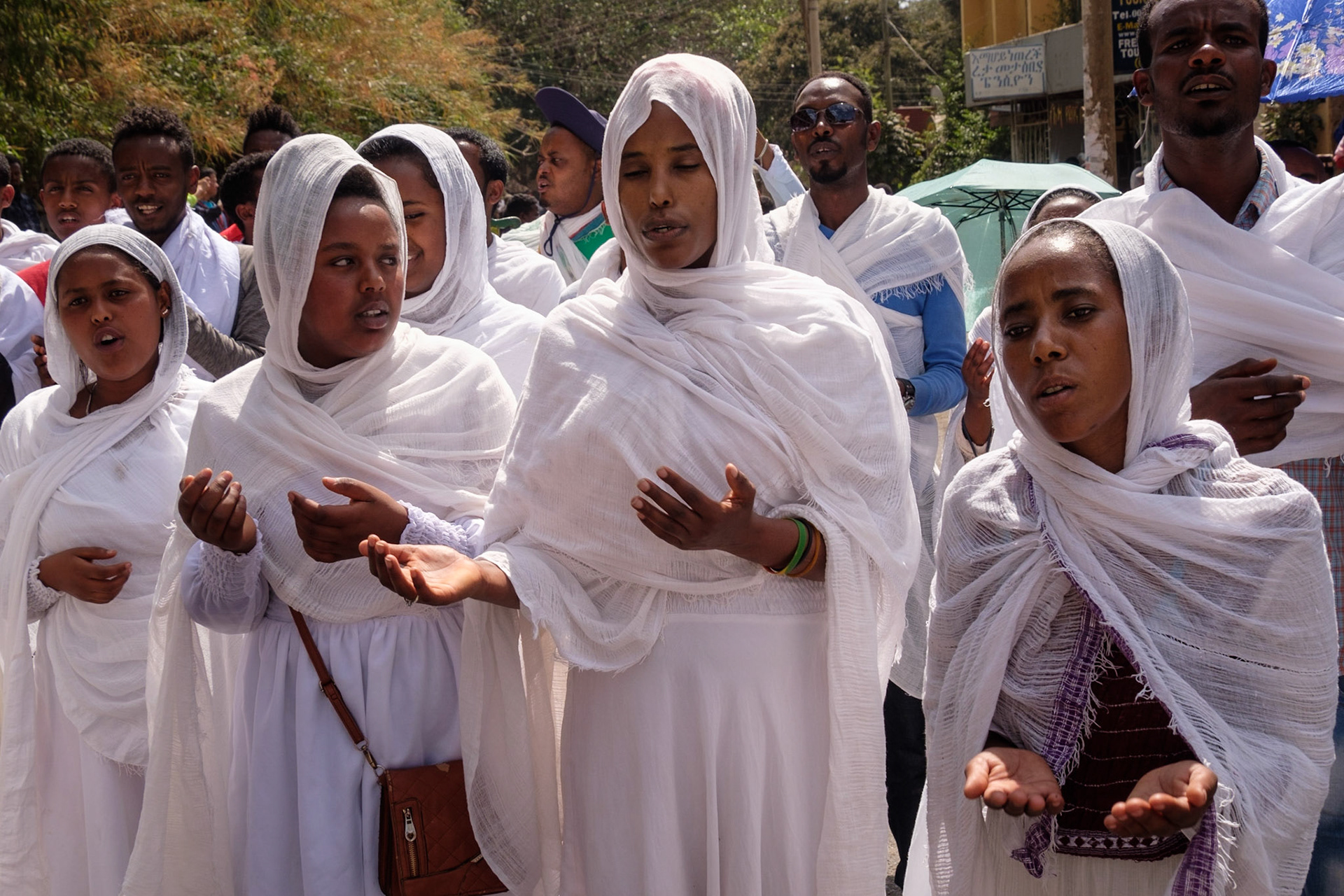


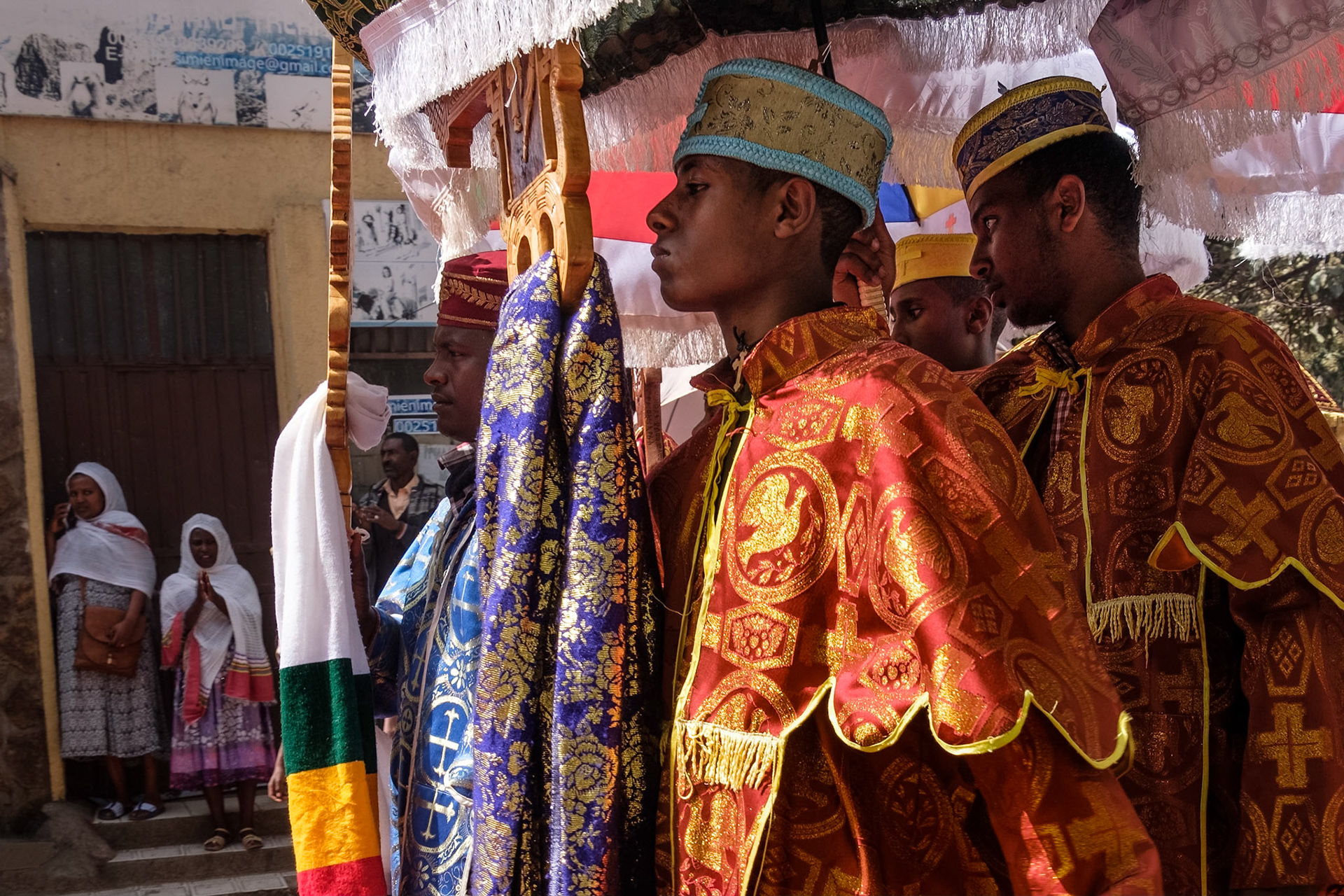
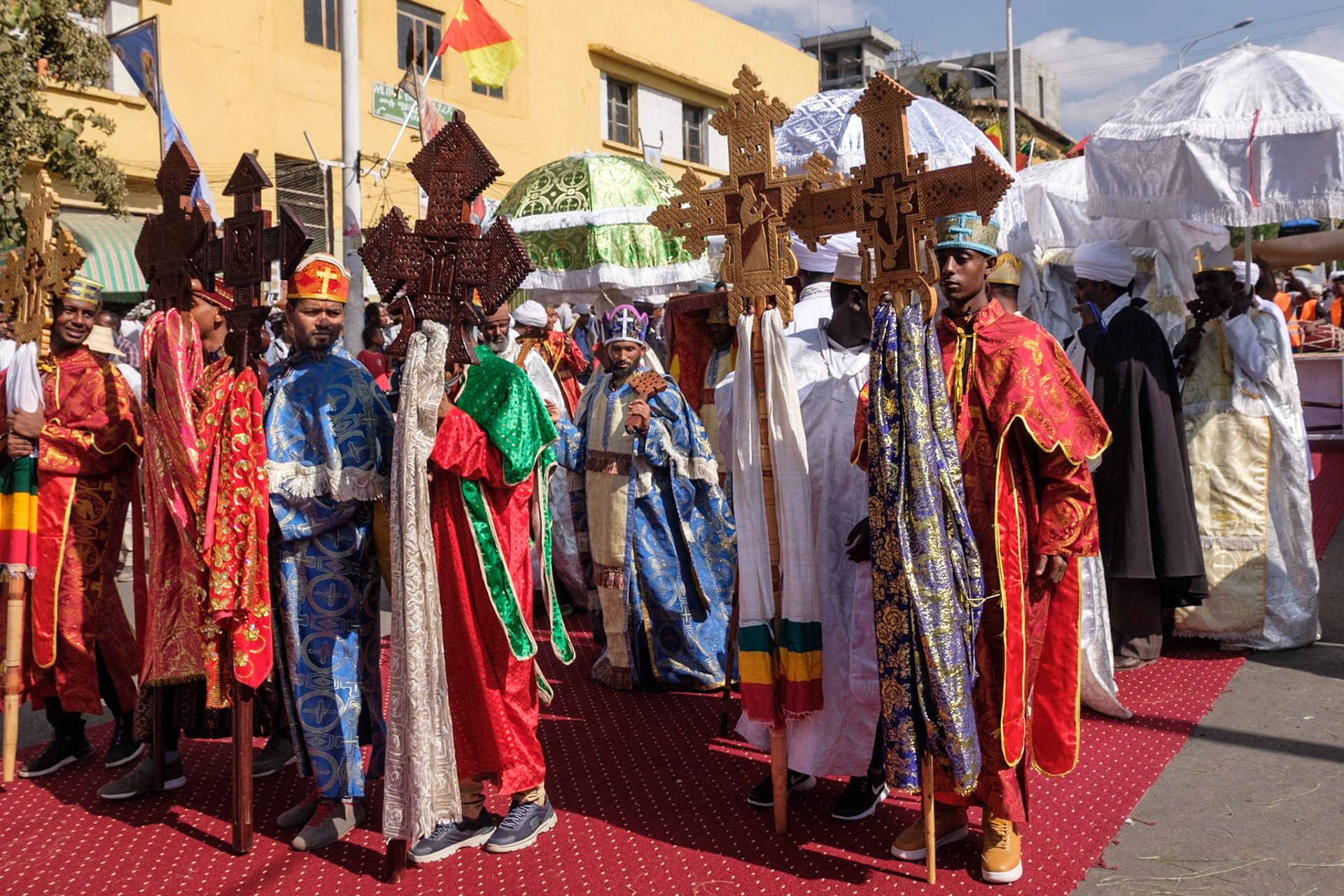
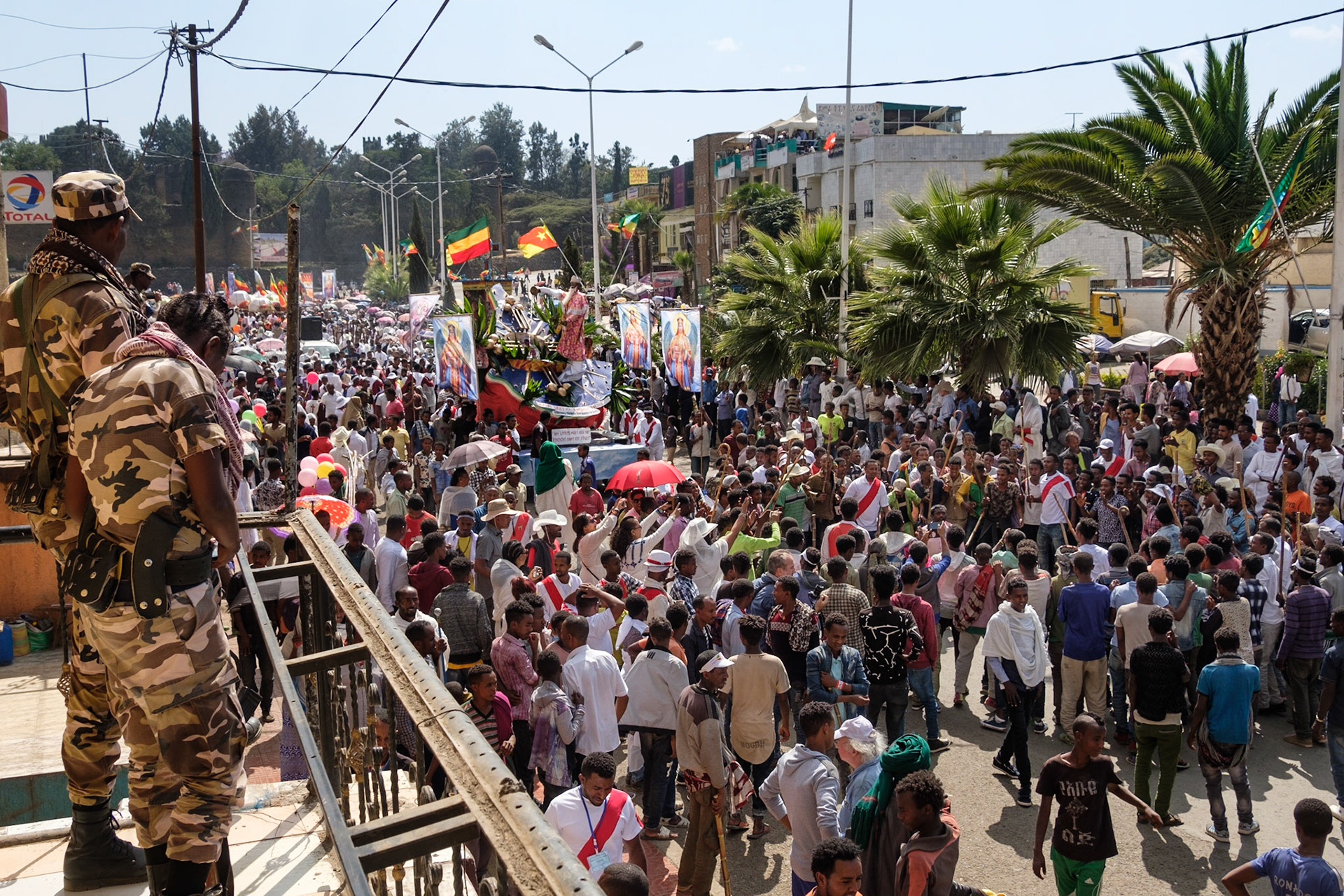
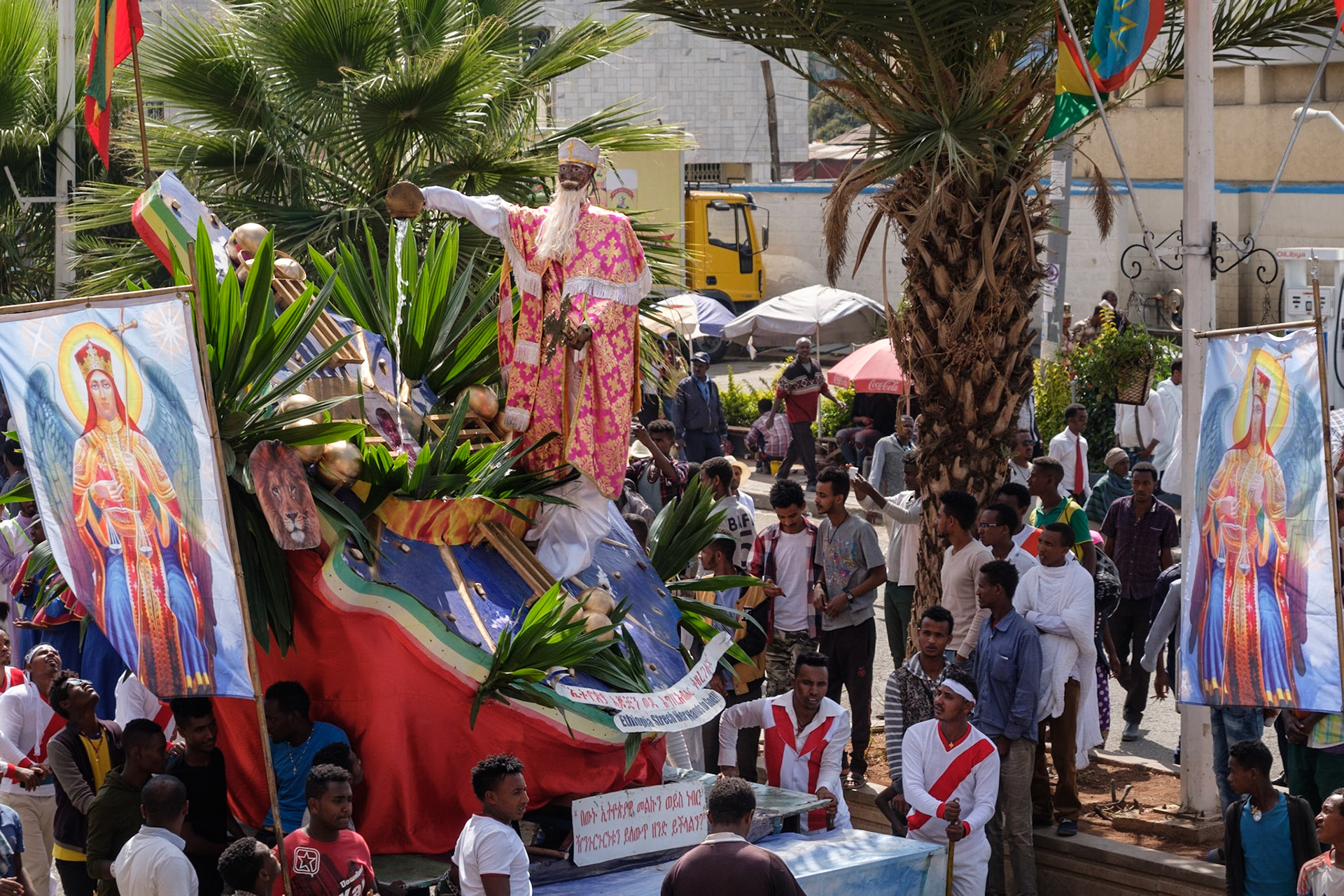
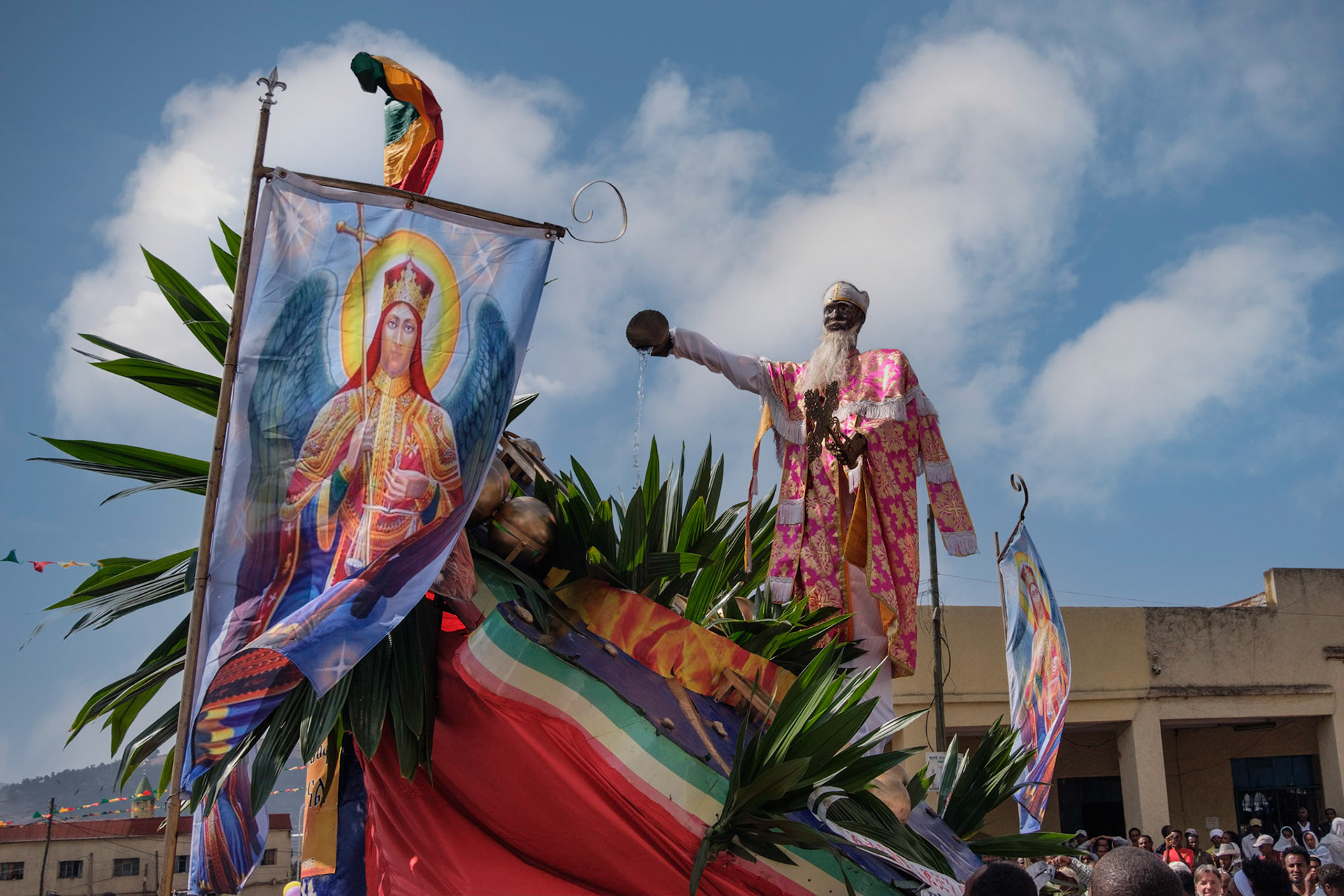
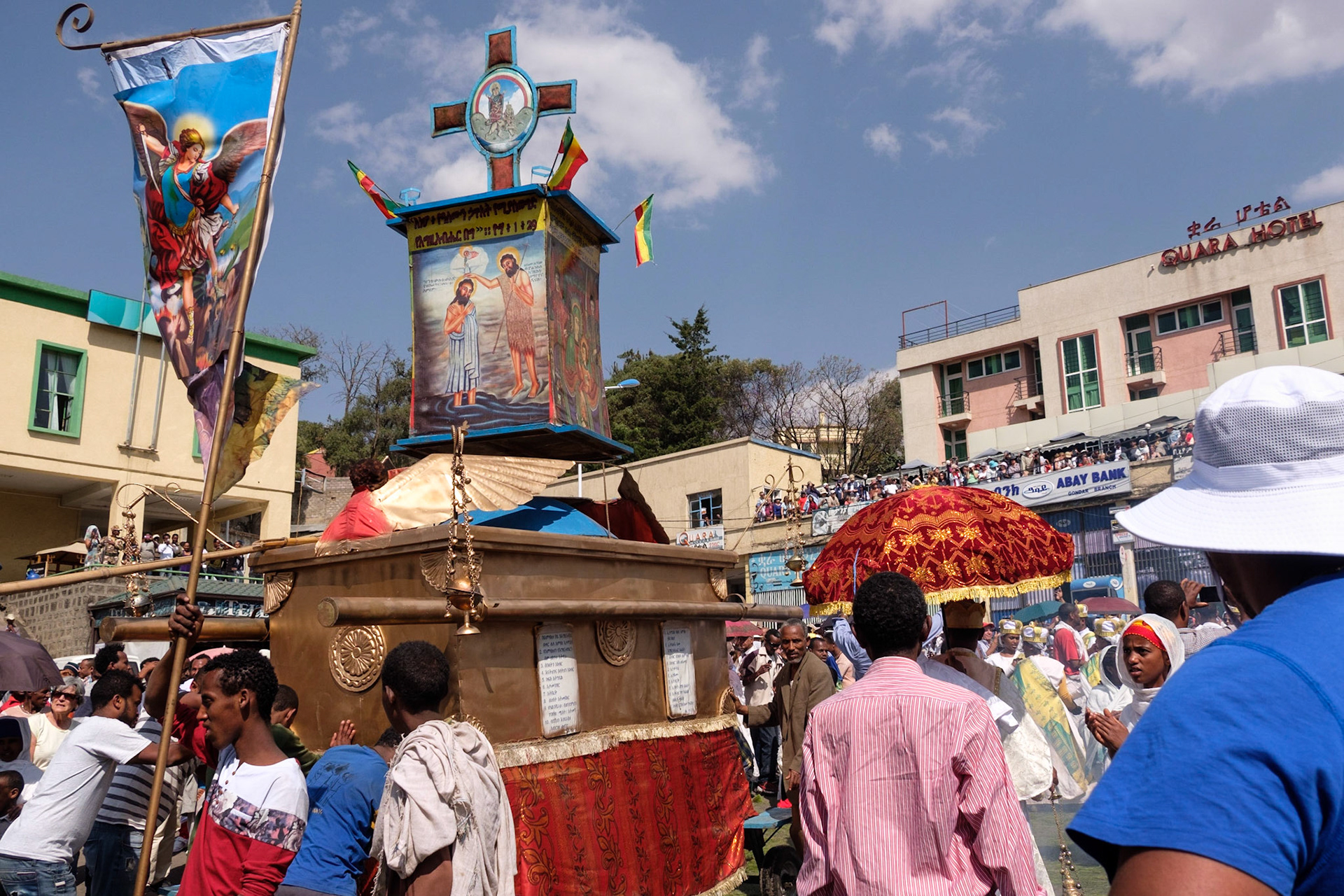



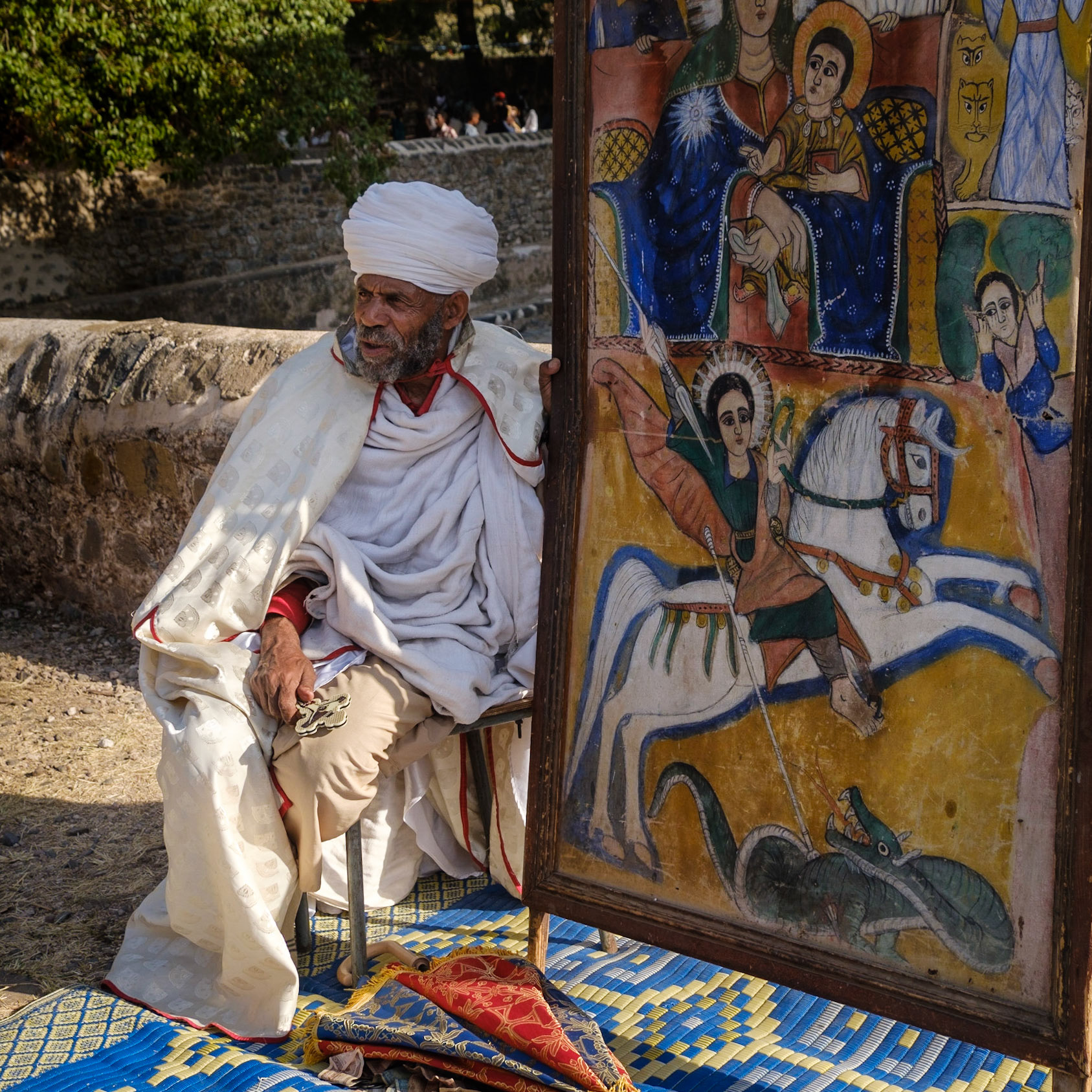
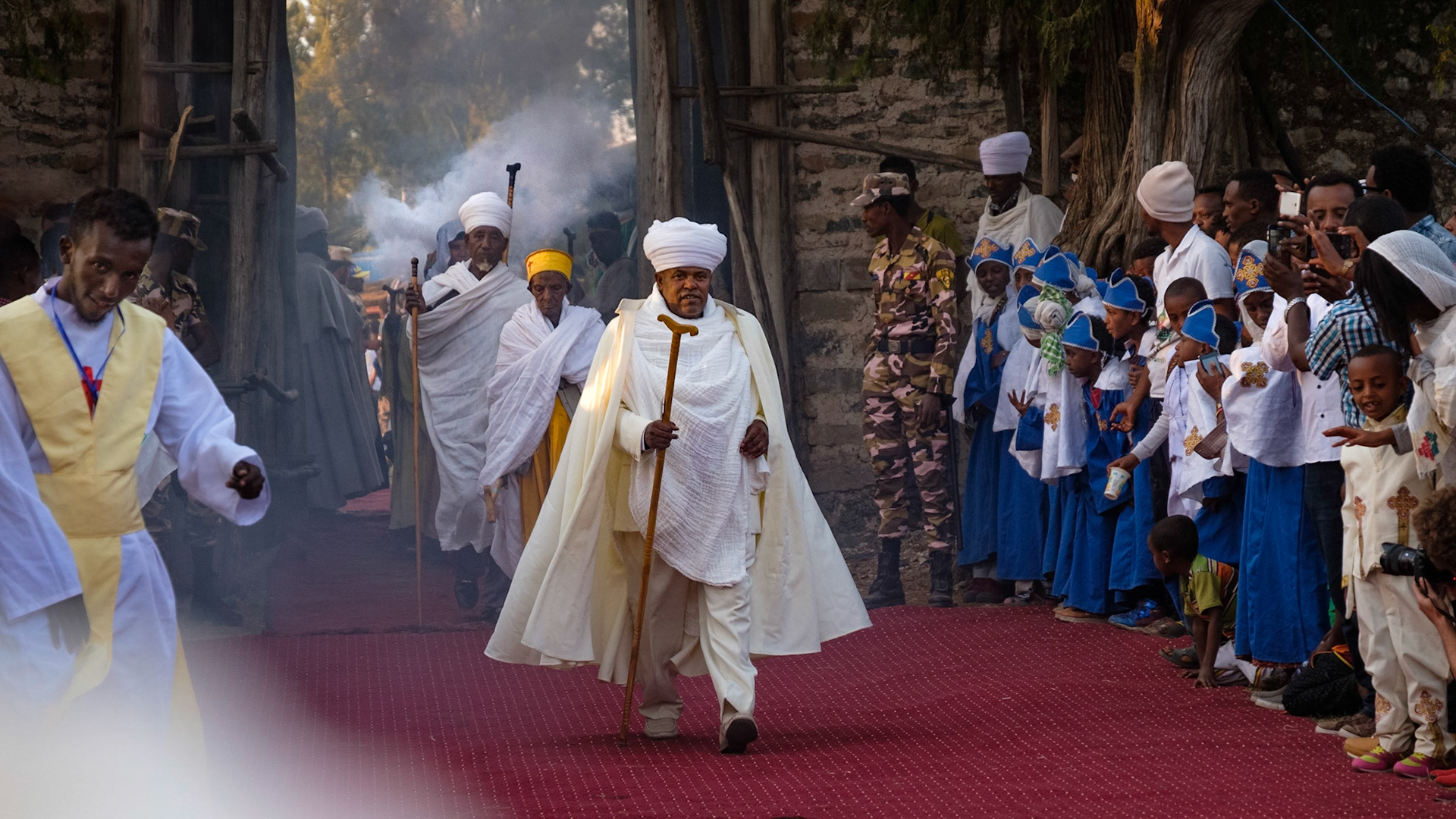
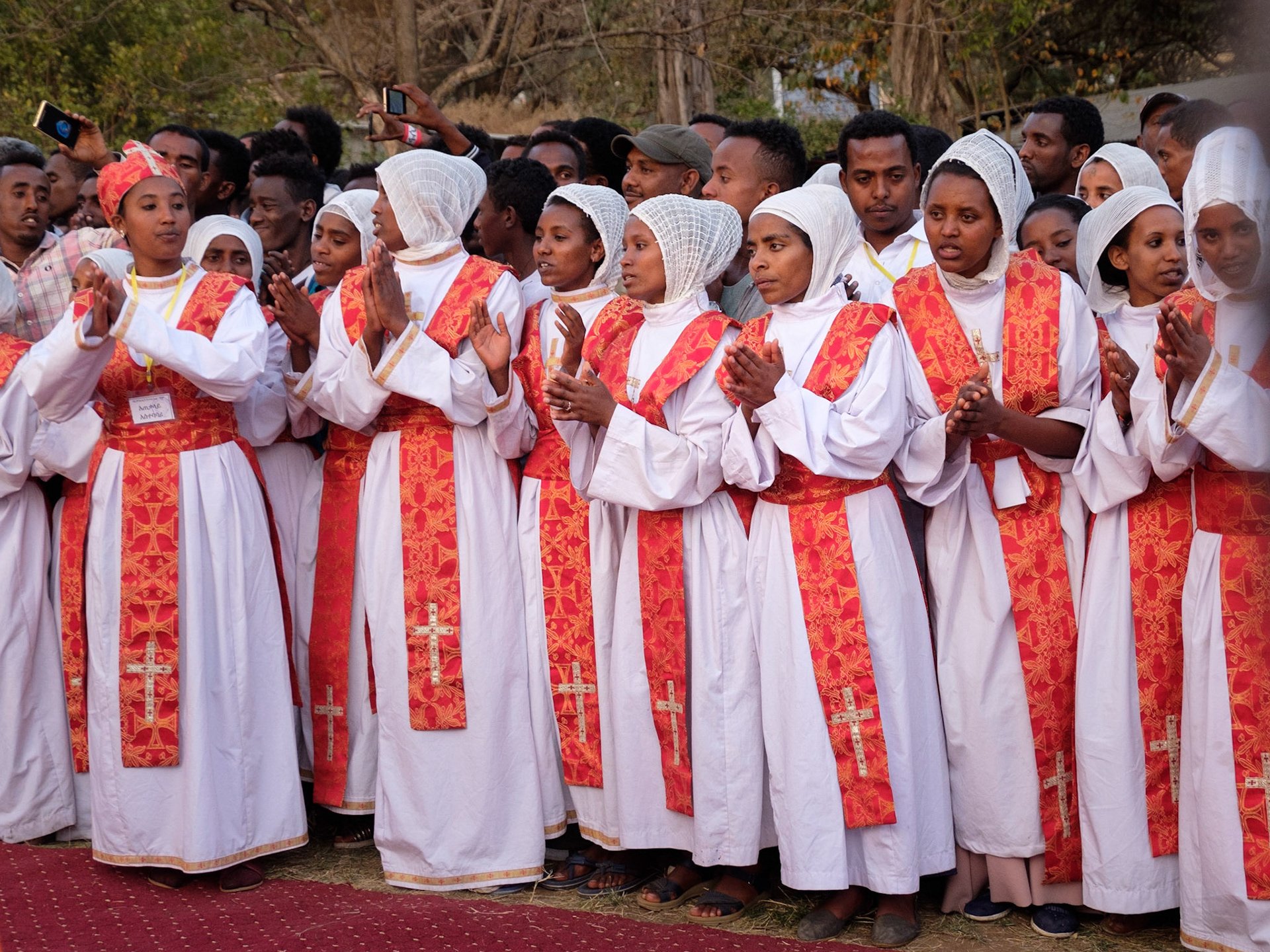
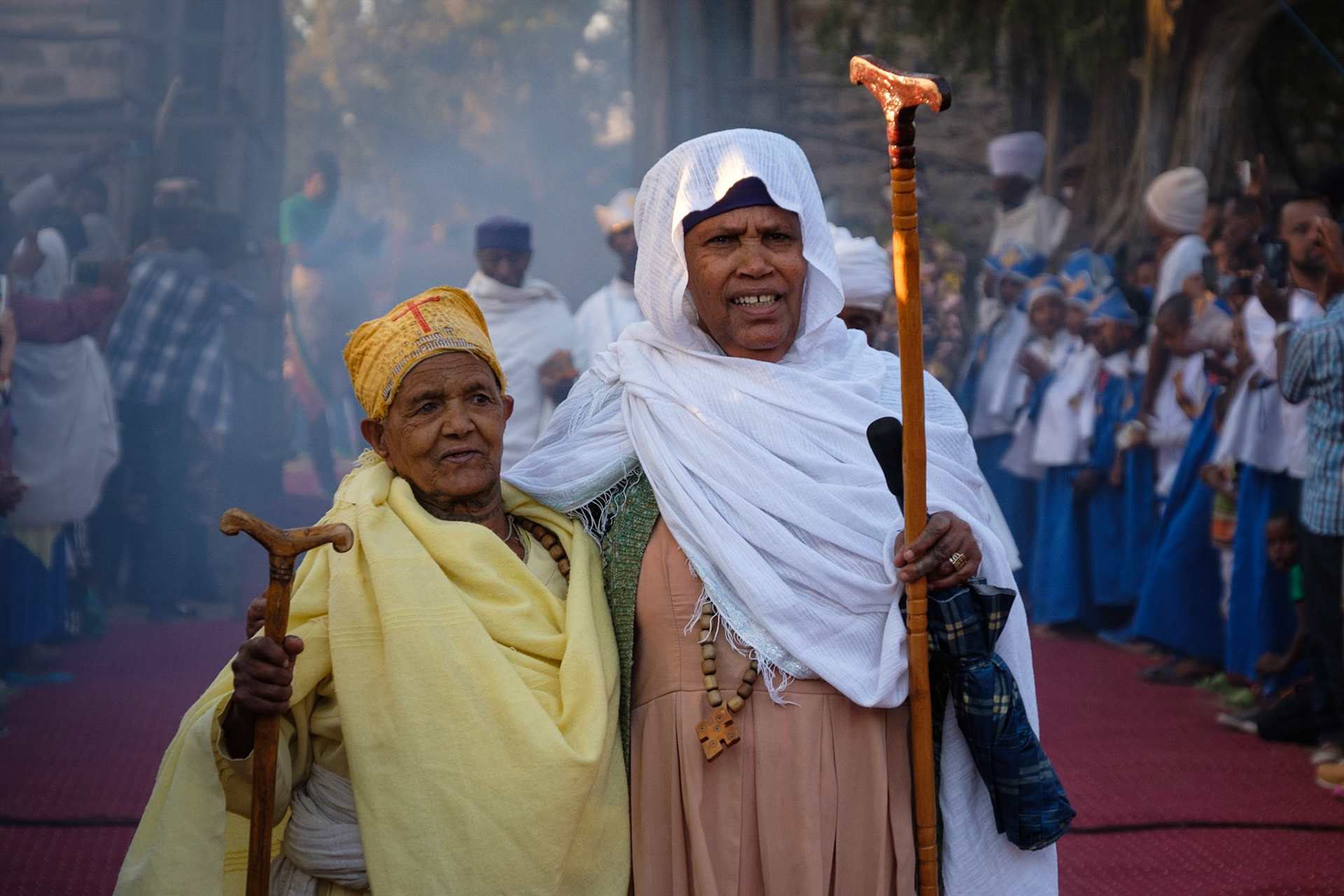
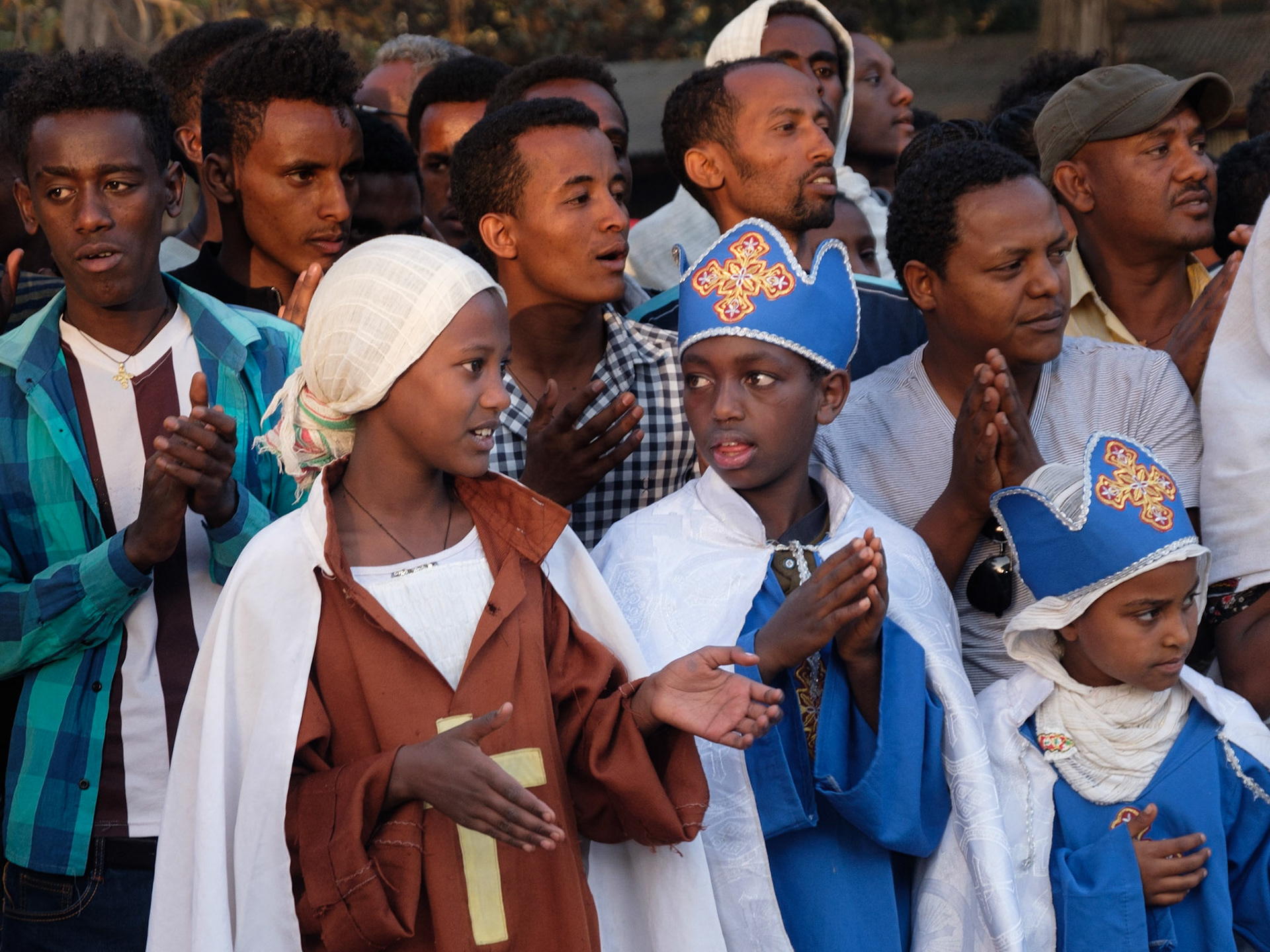

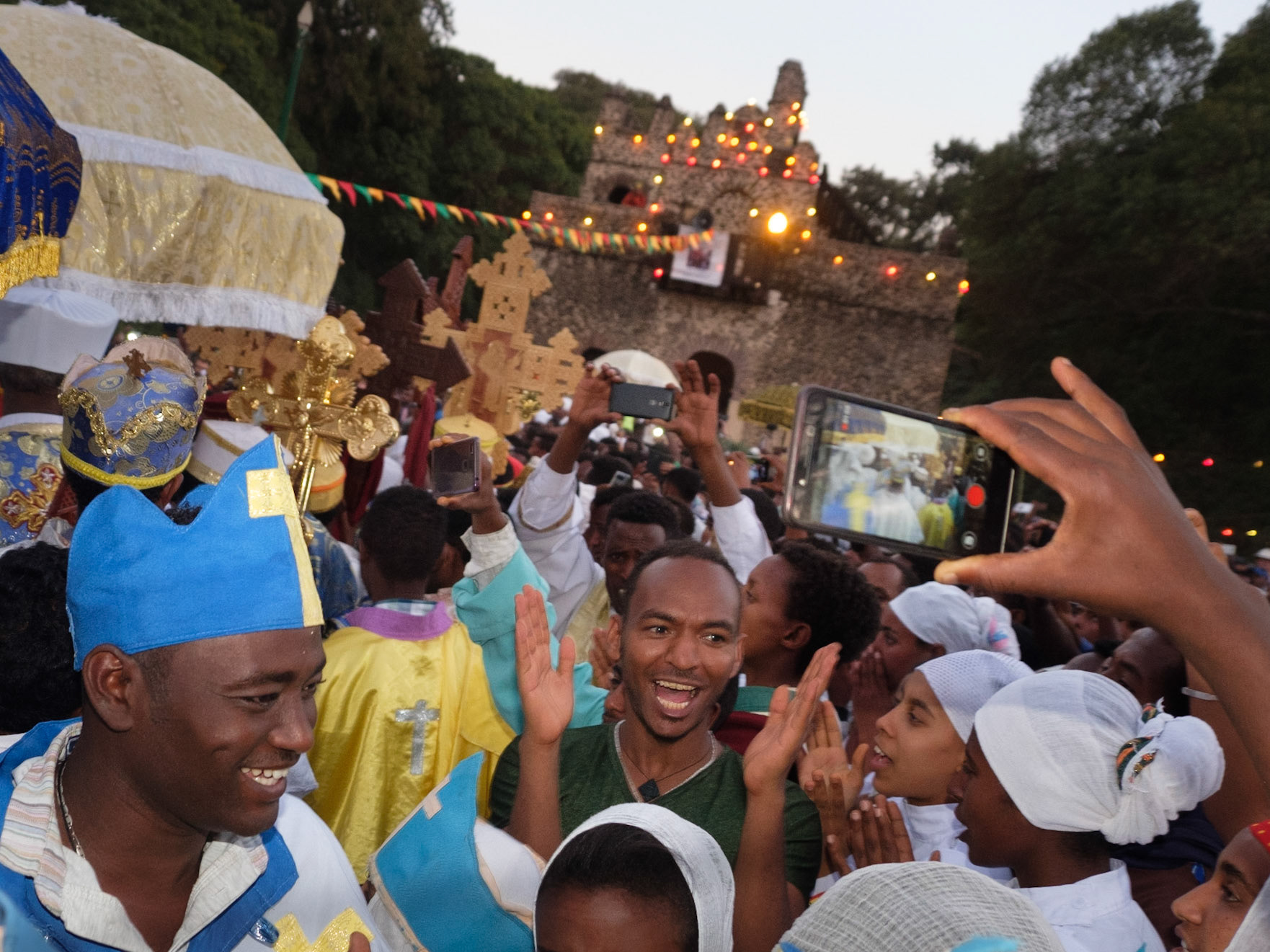


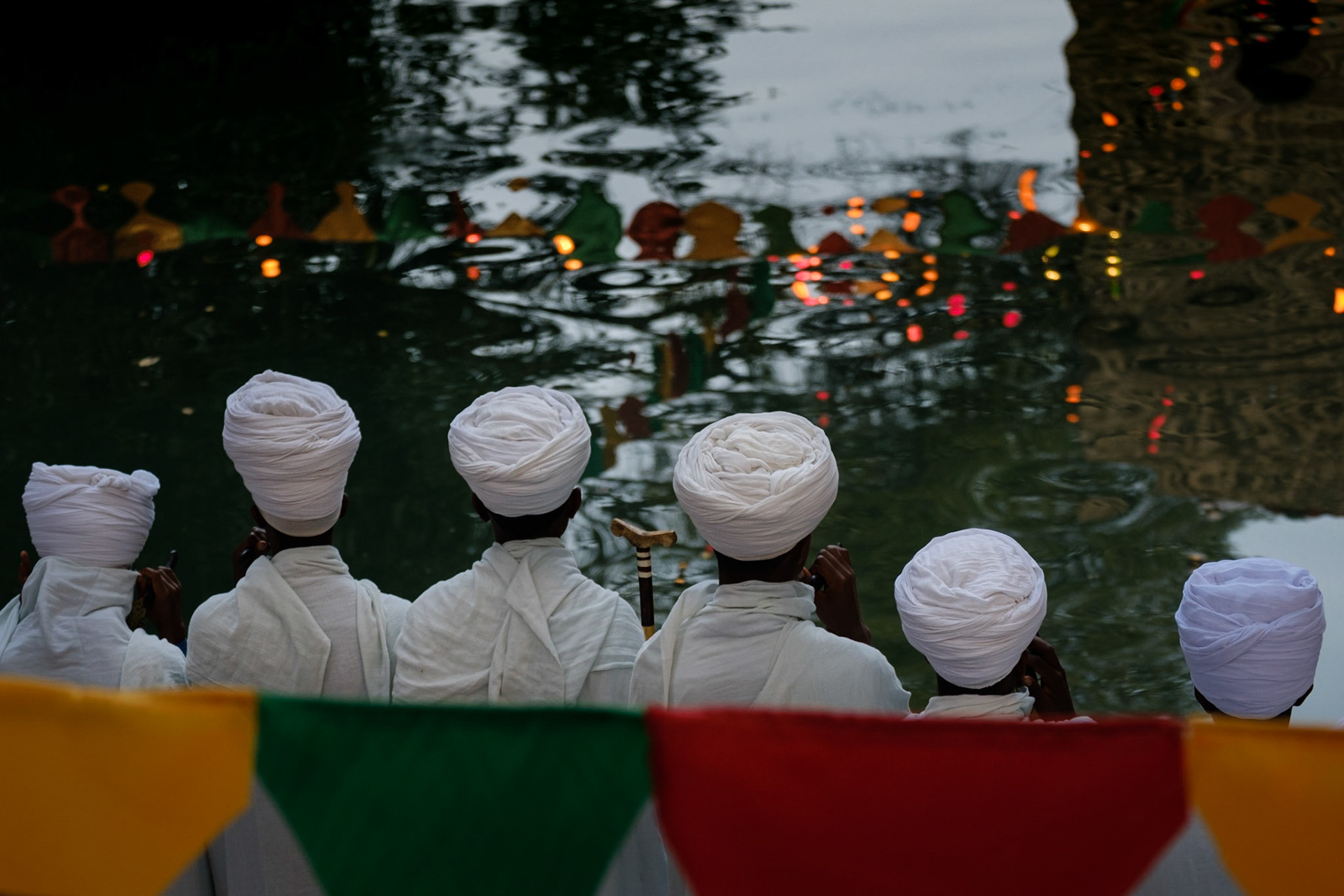

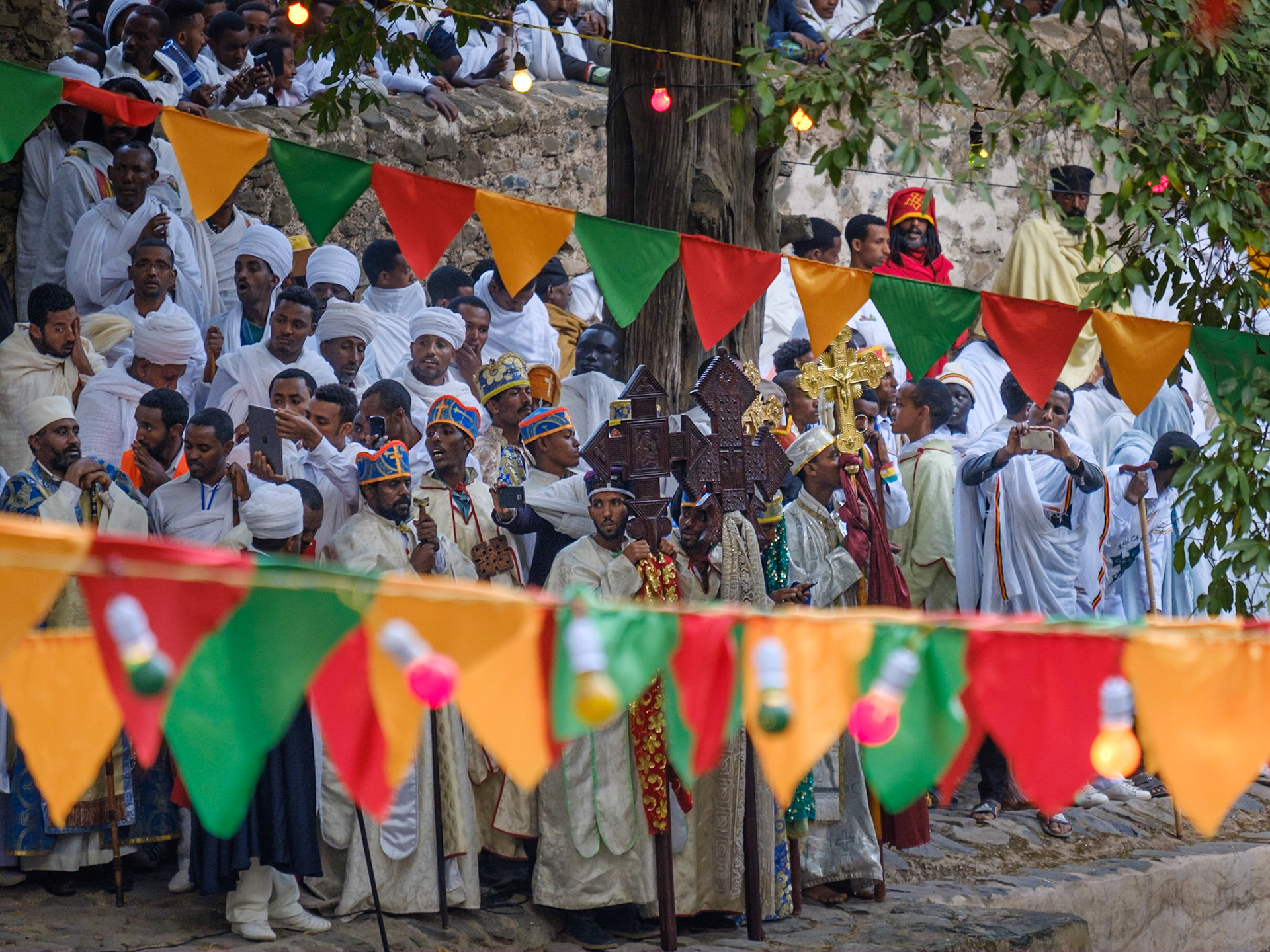
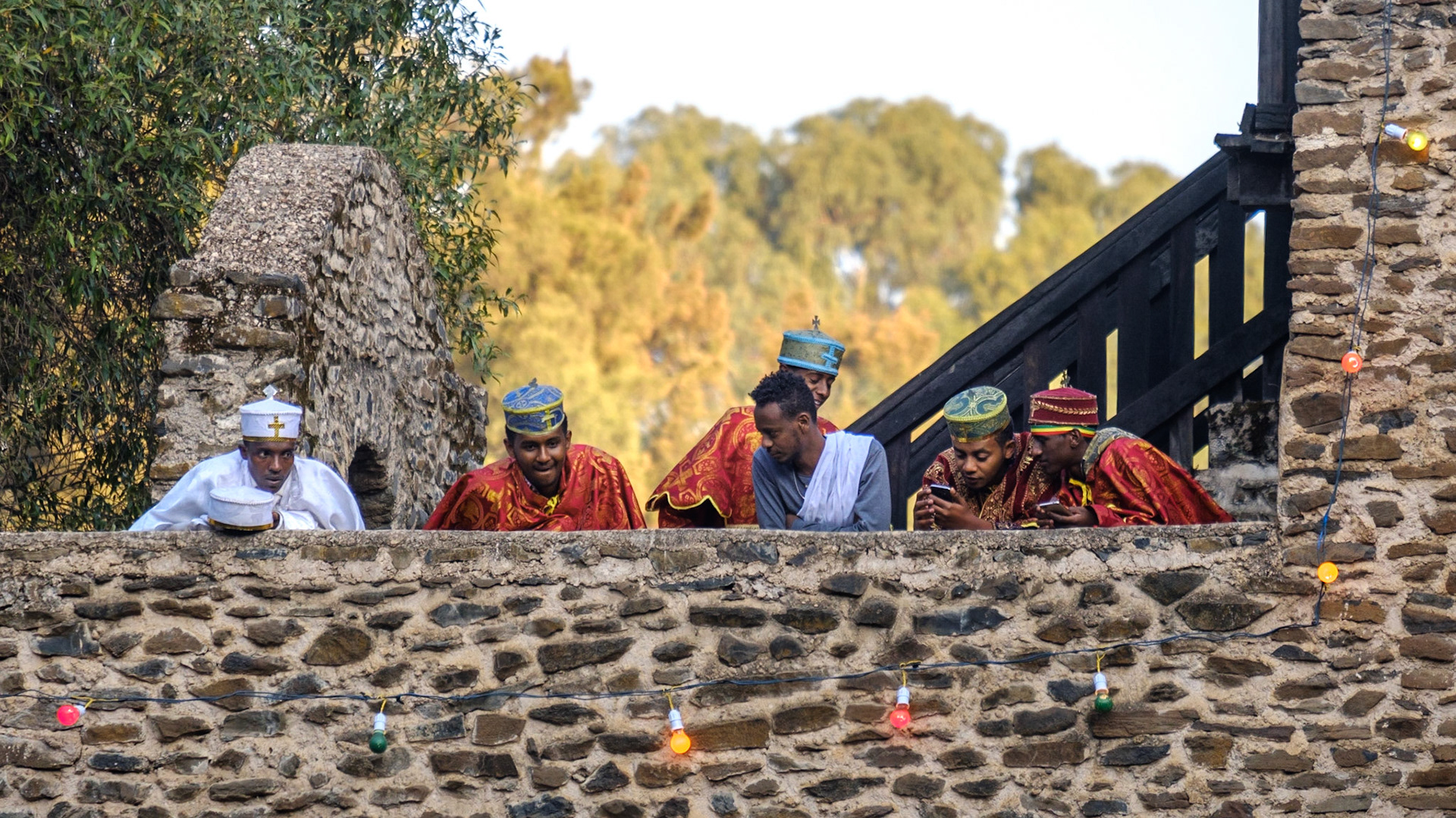


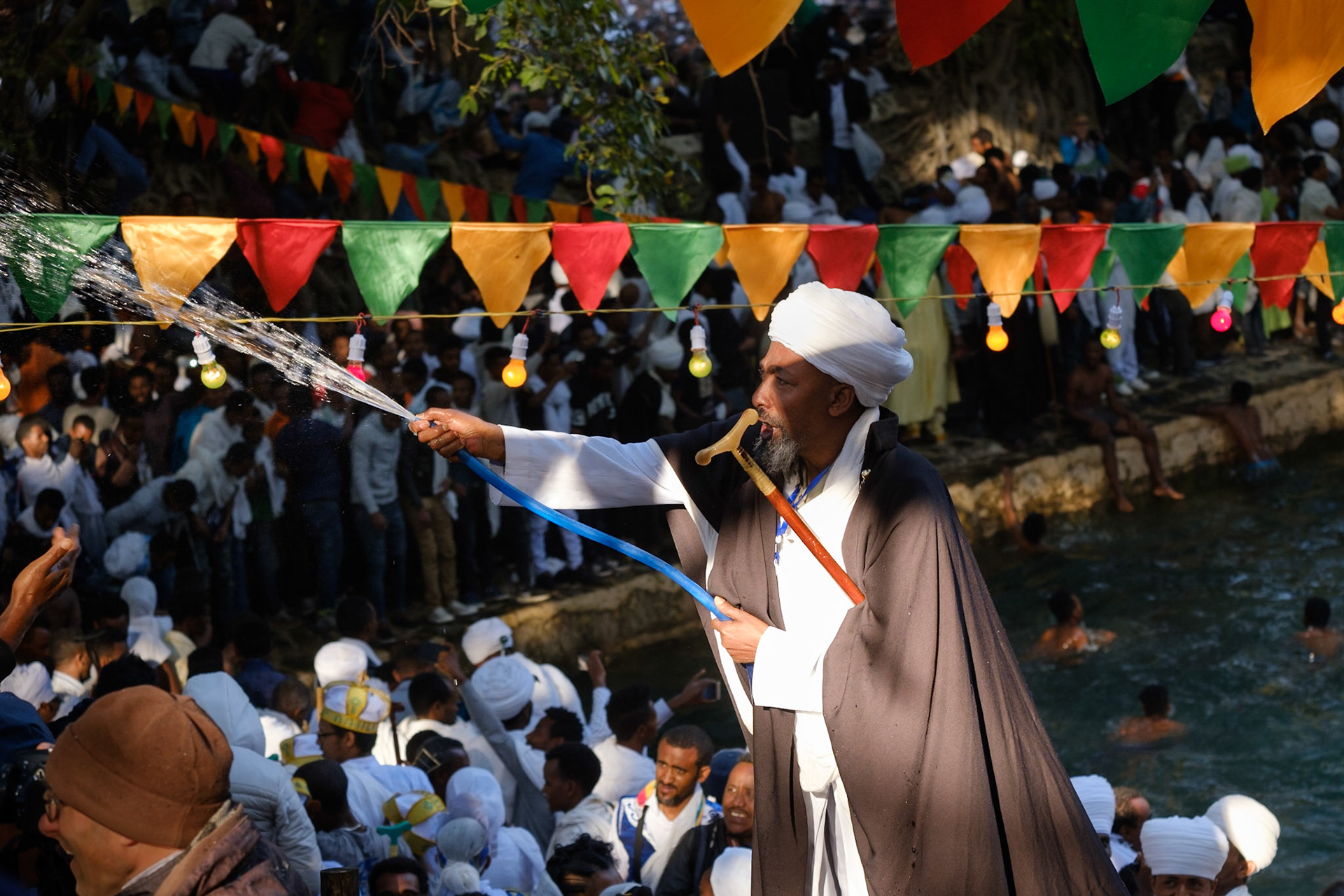
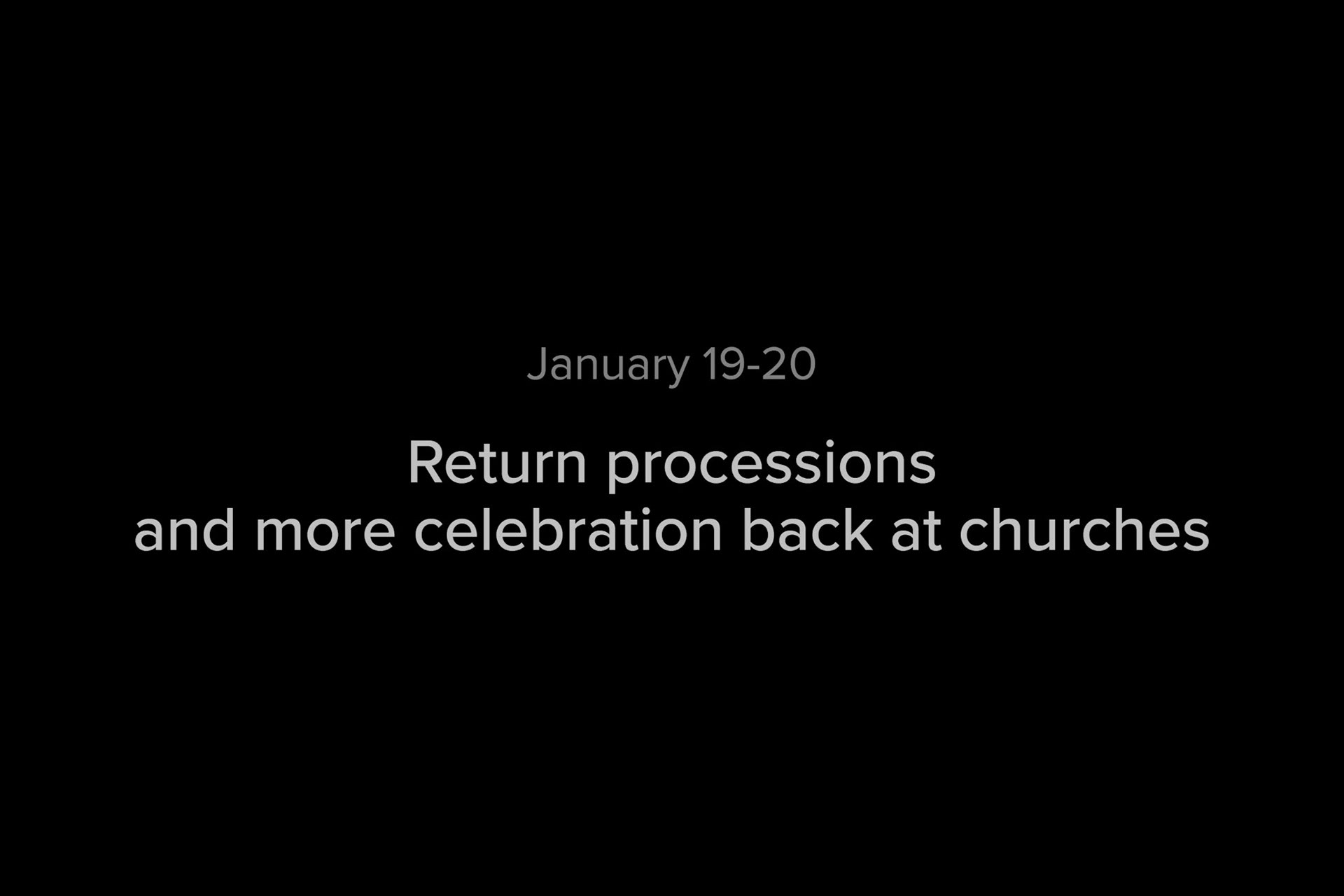
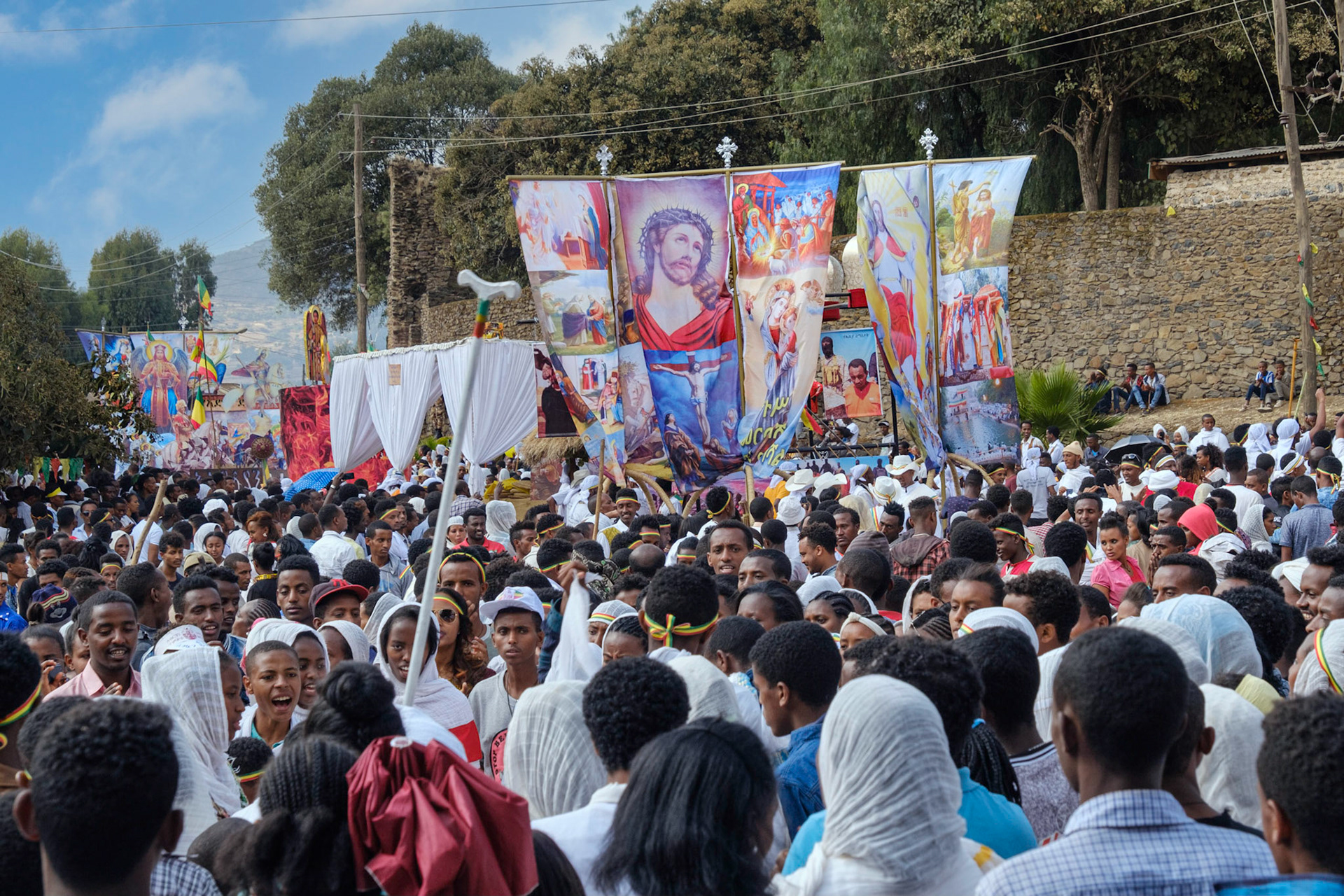
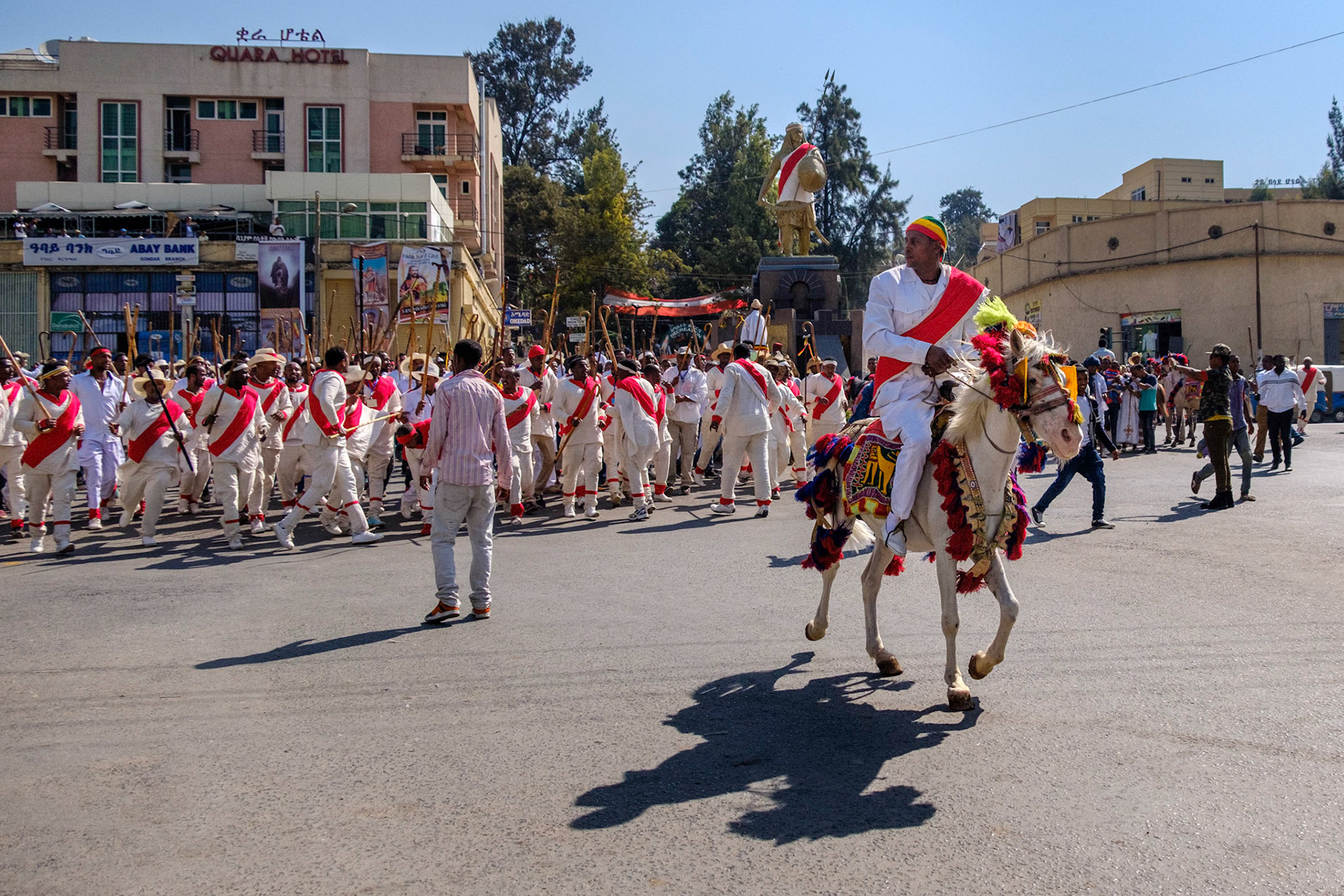

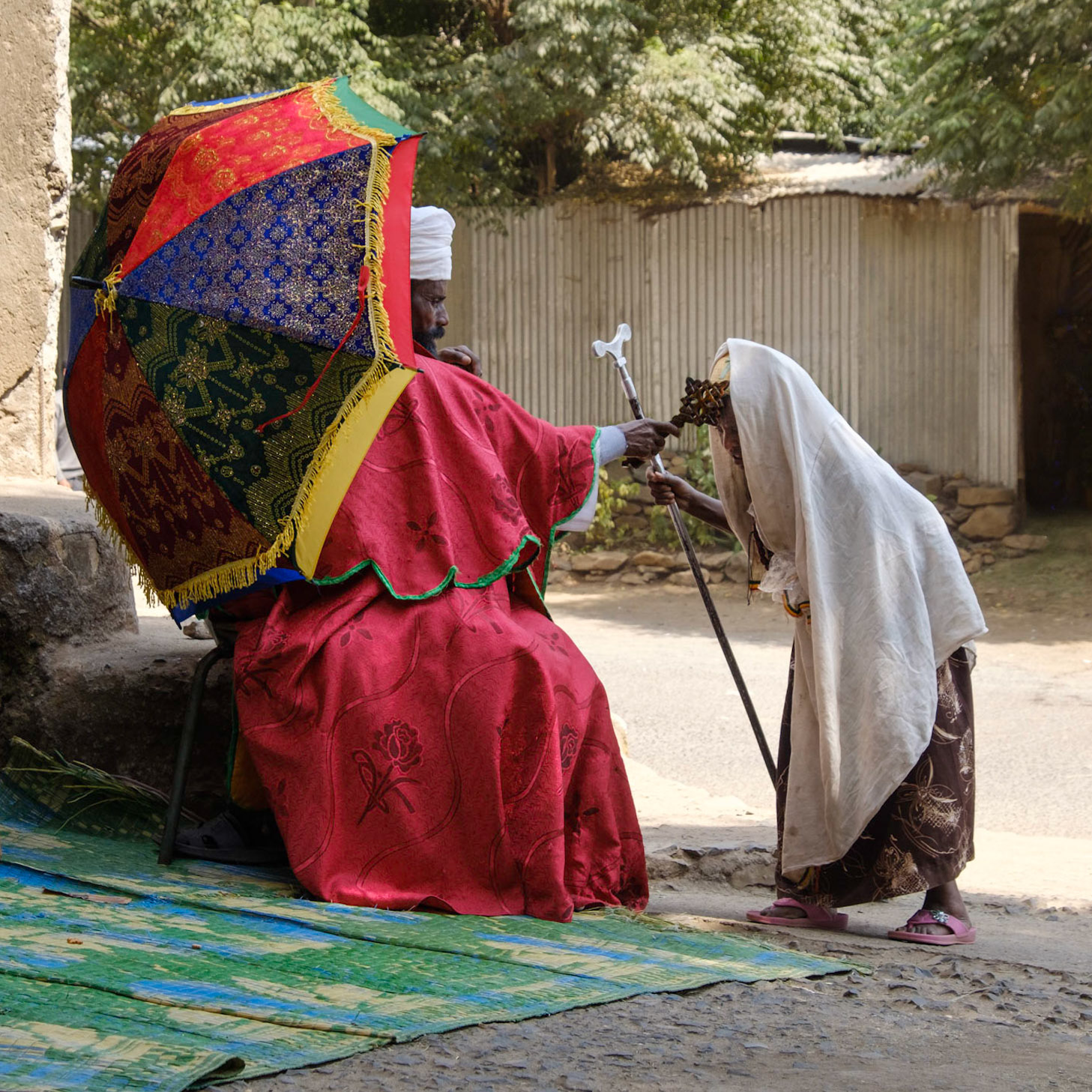




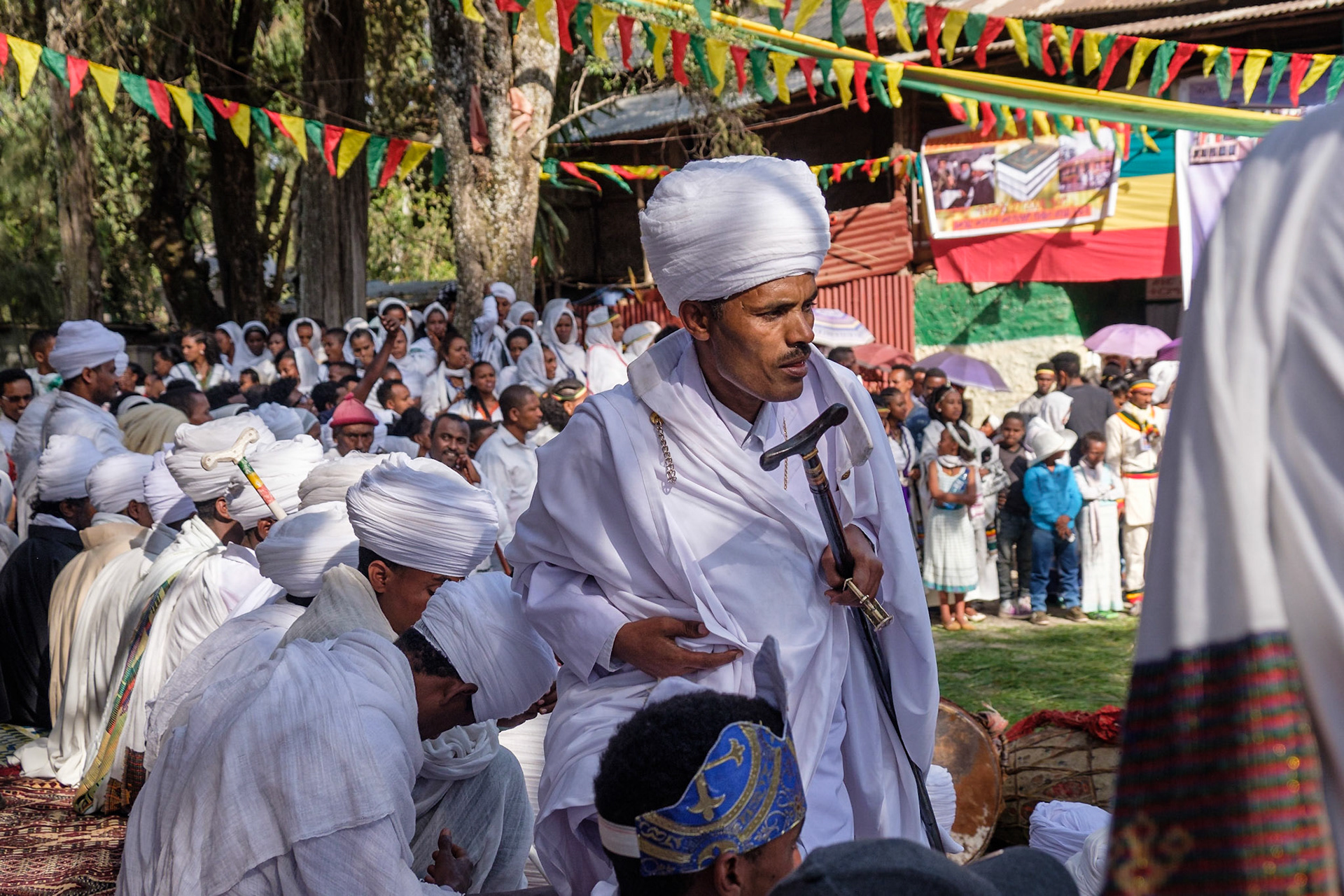


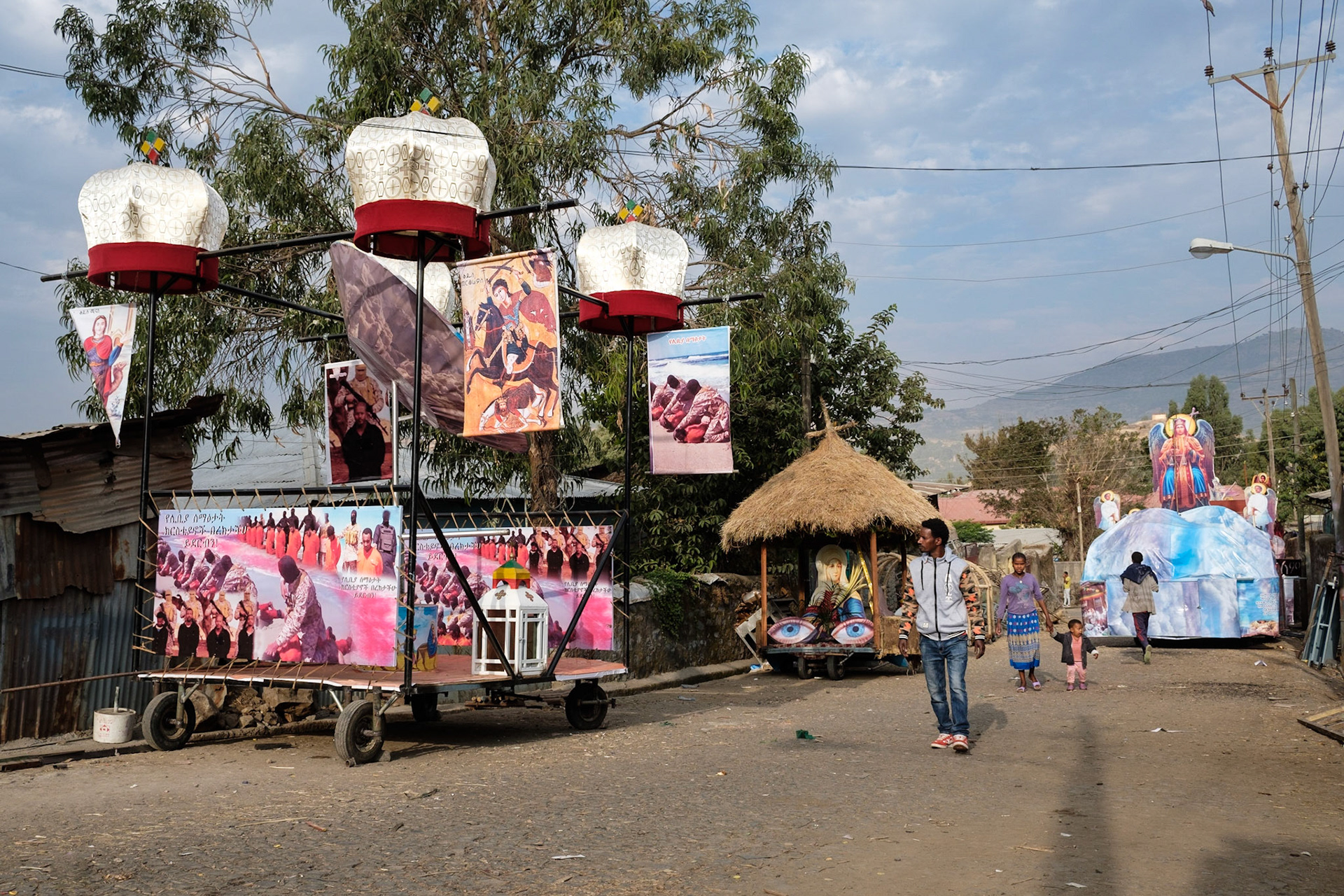
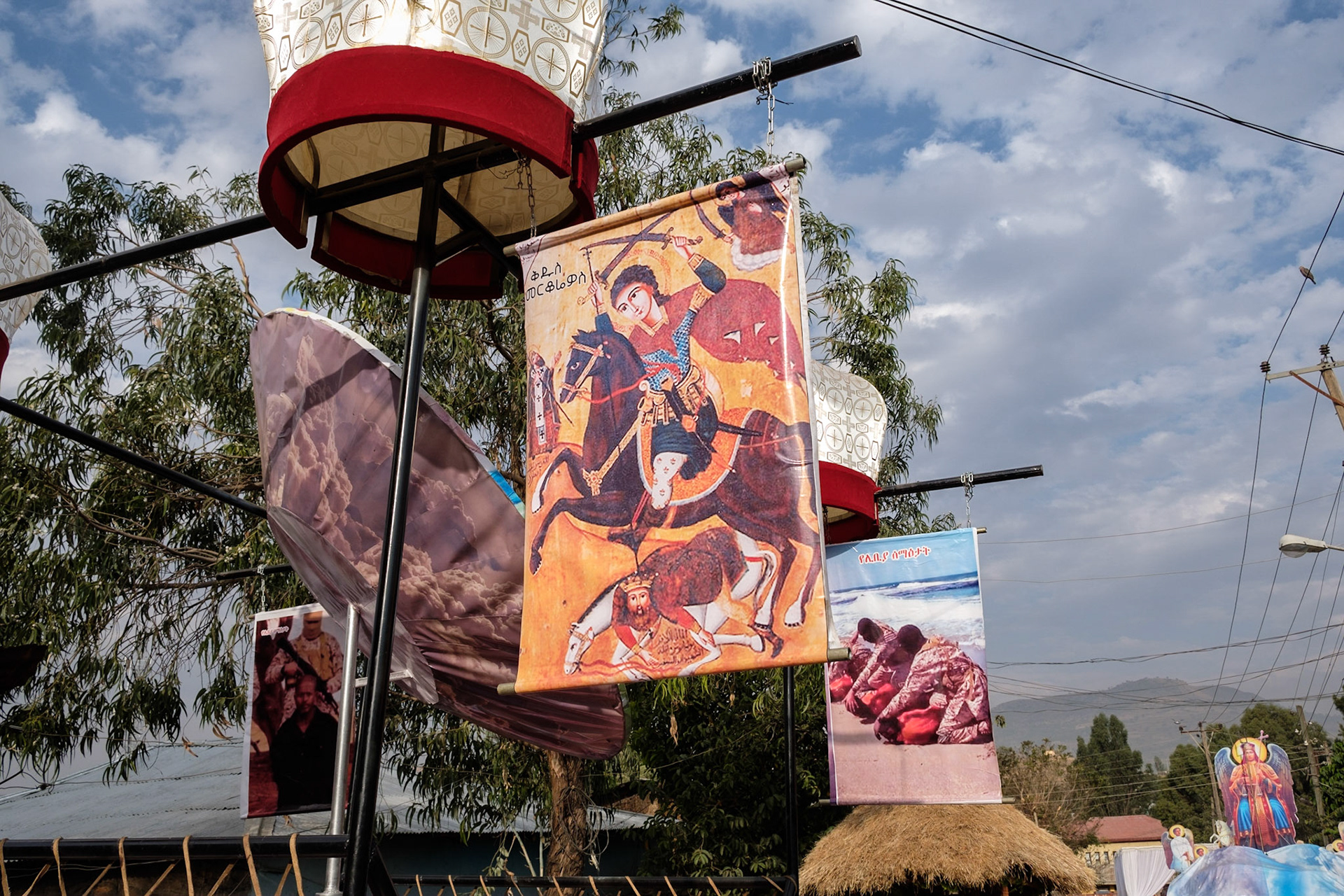

Background story on Timkat in Gondar
Timkat – the Ethiopian flavor of Epiphany
Epiphany is a Christian celebration that takes place 12 days after Christmas, on January 6. However, the Ethiopian Orthodox Tewahedo Church uses a variant of the Julian calendar that is offset by 13 days, relative to the western calendar, meaning that in Ethiopia Epiphany is celebrated on the day known as January 19 (or 20 in leap years) in the western calendar.
The Ethiopian name for Epiphany is Timkat (or Timket), but it is important to note that what is honored is quite different in Western and Orthodox churches. While in the West it is mostly a commemoration of the adoration of the Jesus child by Magi/Wise Men/Kings from the East, in the Orthodox Churches, including the Ethiopian it is related to Jesus being baptized by John the Baptist in the Jordan River.
It may be interesting to note the very different emphasis these two events have in the Gospels. The adoration of the Jesus child by Magi/Wise Men is only mentioned in one Gospel, that of Matthew (2:1-11), and although Epiphany is widely known in the West as the Feast of the Three Holy Kings, there is no mention of a specific number of visitors, nor that they were Kings in Matthew.
On the other hand, the baptism of Jesus by John the Baptist in the Jordan River, and the following immediate unveiling of Jesus as the Son of God, marking the beginning of his ministry is described in all three synoptic Gospels (Matt 3:13-17; Mark 1:9-11; Luke 3:21-22), with a somewhat similar scene occuring in John (1:29-34). This is obviously an event of huge significance for believers and helps explain why Timkat is often considered the biggest Christian festival in Ethiopia. In 2019, UNESCO acknowledged its importance by inscribing Timkat on its Representative List of the Intangible Cultural Heritage of Humanity.
The Ethiopian Orthodox Tewahedo Church
The Ethiopian Orthodox Church is so unique that it deserves some words. Ethiopia was one of the first two countries (the other being Armenia) to adopt Christianity as a state religion in the early 4th century. In all likelihood, Christians came to Ethiopia long before that; possibly as early as the first century, at which time Judaism was already well represented in the country. Interesting, Acts 8:26-40 describes how an Ethiopian eunuch came to be baptized by Philip.
Ge’ez, an ancient Ethiopian language, was among the first languages the bible was translated to, and the Orthodox Ethiopian version contains a wider selection of books than that of any other Christian Church (81 books, as compared to 66 in the Kings James Bible).
In the centuries after the rapid spread of Islam, Ethiopia became surrounded by Islamic countries and contact with other churches became difficult. For these reasons, the bible and living practices of the Orthodox Ethiopian Church are rich and unique sources of information about early Christianity.
A characteristic of the Ethiopian Orthodox Church is that it has retained more elements from Judaism than other churches, such as male circumcision, and kosher regulations. Even for lay people there are 180 mandatory fasting days in the year (up to 252 for clergy), where the faithful have only one meal, do not drink or eat until at least midday, or better, mid-afternoon, and abstain from animal products.
Services in the Ethiopian Orthodox Church typically last many hours, and require participants to stand for extended periods, which is why long, so-called prayer sticks that can be leaned on are very popular.
The Ark of the Covenant and the Tabot
According to the Ethiopian Orthodox Church, the original Ark of the Covenant with the ten commandment tablets, dating back to Moses is kept in the church Our Lady Mary of Zion in Axum, where only a single guardian priest, appointed for lifetime is allowed to see it (international scholars are naturally skeptical about this claim).
Nevertheless, so-called Tabots, considered replicas of the ten commandment tablets are very important objects and concepts in the Ethiopian Church. Tabots are usually about 15-30 cm square and can be made from wood or stone, such as marble or alabaster. They are always wrapped in ornate textiles, and rarely removed from the innermost part of the church they belong to, where only clergy has access.
It is hard to exaggerate the importance of the Tabot: Every church is founded on a Tabot that has been consecrated for that particular church. Without the Tabot there is no church, and where the Tabot goes, there is the church. Tabots are believed to hold immense spiritual power, and therefore must be present during the rituals of Timkat, which offer the best once-a-year opportunity for lay people to be close to one.
The Timkat celebration
Timkat is a complex, multi-faceted, multi day celebration commemorating the baptism of Jesus, where the Tabots play an important role. In large cities, tens of thousands may participate.
On January 18 (in the Western, Gregorian calendar) the celebration begins in the early afternoon with colorful and spectacular processions starting out from each church, and usually merging at a central point in the city.
At the heart of each church’s procession is its senior priest, dressed in ornate clothes, and carrying on his head the Tabot of his church, wrapped in gold and silver embroidered fabrics. Other priests, also elaborately dressed, and carrying colorful umbrellas surround the senior priest. Large groups of Sunday school children dressed in uniforms sing and dance, and large drums, simple brass horns, string instruments and sistra provide music.
The procession has as its destination a body of water, where the main ceremony will happen the following morning. The route may be several kilometers long, and lined with spectators that participate enthusiastically by singing, chanting, dancing and clapping. During the whole procession, from stepping out of the church building, until arrival at the destination the priest carrying the Tabot on his head, and the priests surrounding him never touch the ground: read carpets are continuously rolled out in front of them, rolled up behind them, and rushed to the front by a group of young men.
Late in the afternoon, the processions arrive at the end point, be it a river, a lake, or a pool constructed for the ritual that is to take place the following morning. Here the Tabots from the different churches are collected, and kept in a tent or building, closely guarded by priests, during the night. Thousands, or tens of thousands of participants who have followed the procession will continue celebrating here during the evening, with sermons, singing, chanting and dancing, spending the night outdoors.
Very, very early the following morning, on January 19, and hours before sunrise, an elaborate religious service starts with the participation of a large number of priests and led by the most prominent one present. After several hours, around sunrise, the service culminates when the leading priest blesses the body of water in the name of The Father, The Son, and the Holy Spirit while touching its surface with a huge gilded cross.
In that moment the whole atmosphere of the ceremony is transformed as an explosion of joy moves through the crowd of participants, young men jump into, and start to swim around in the water. Soon thereafter priests begin to sprinkle holy water on participants outside the pool, using plastic garden hoses. Some participants fill receptacles with Holy water to bring back home, for healing purposes.
A few hours later, the processions from the previous day are played in reverse, with the same level of enthusiasm, as the Tabots are taken back to the churches where they belong. Here, they are received with considerable ceremony, before being placed back in safety, in the innermost part of the church. For churches dedicated to St. Michael the procession to return the Tabot home is postponed until the following day, January 20, thus making Timkat a 3-day event. With the Tabot safely returned to its church, participants go home and continue the celebration over a healthy meal.
To participate in the Timkat celebration is an extraordinary experience. In much of Western Christianity, liturgy is largely a spectator sport. Not so, with Timkat; it is all about embodied participation, and the ceremonial palette is brilliantly constructed so that there is something to do for everyone: the pious, the children, young men who have lots of energy to burn, old people, etc. Timkat is also a study in huge contrasts on many levels. On one hand, it is obvious that the solemn sacredness of the rituals is very real to many; on the other, ecstatic joy and fun flow through the crowds, while ancient ceremonies are captured with smartphones.
Gondar
Now it is time to mention why Gondar (or Gonder), a city in Northern Ethiopia with a current population of about 325,000 is particularly interesting in relation to Timkat.
In 1635 emperor Fasilides founded Gondar as a city and royal residence. Rulers following him continued to add their own palaces, and other buildings to what became a fortified Royal Enclosure, or mini city, called Fasil Ghebbi, covering about 70,000 square meters. Even today, a number of these buildings are preserved quite well, and although others are in ruins, the complex is a major Ethiopian tourist attraction.
Related to the Royal Enclosure but located a couple of kilometers from it is a unique structure, the Fasilides’ Bath, likely built around 1650. The bath complex consists of a huge pool, around 1,500 square meters that can be filled from, and emptied into a nearby river. A tower, in the shape of a small castle stands in the pool, connected by a bridge to the edge of the basin. Pool and mini-castle are located within a walled area, covering about 20,000 square meters that can accommodate tens of thousands of people. With walls overgrown by banyan trees, the Fasilides’ Bath provides a remarkable backdrop for celebrating Timkat, and it is quite the spectacle to see hundreds of young men jump into the pool the exact moment the water is blessed. In addition, the route from the churches in the city to the Fasilides’ bath provides lots of opportunity to enjoy the procession, as it is more than 2 kilometers long.
A sad postscript
Many of the photographs above, from the ceremony at the Fasilides Bath, were taken from a spectator stand at the short edge of the pool, facing the castle-like tower in the pool. The stand was a traditional wooden construction, built from long, slender trunks of young trees, much the same way as scaffolding for building construction is often made in Ethiopia.
Unfortunately, during the 2020 celebration, only about a month after UNESCO had inscribed Timkat on the Representative List of the Intangible Cultural Heritage of Humanity, the spectator stand collapsed, leaving at least 10 people dead, and more than 100 injured.
